Quick Camper Van Getaways Near the San Francisco Bay Area
Quick Camper Van Getaways Near the San Francisco Bay Area
Photo by Muse & Co. Outdoors
While the Bay Area is beautiful, it also happens to be located within a few hours of some of California’s greatest natural treasures. Places like Big Sur and Lake Tahoe are within a morning’s drive of the Bay and offer a complete change of scenery. Its close proximity to beautiful nature also makes the Bay Area one of the best places in the world to own a camper van.
If you’ve been looking into Bay Area camper van conversions, or you already own a Sprinter van and live in the Bay, this article is for you! Below you will find some recommendations for quick camper van getaways within just a few hours of the Bay Area. Enjoy!
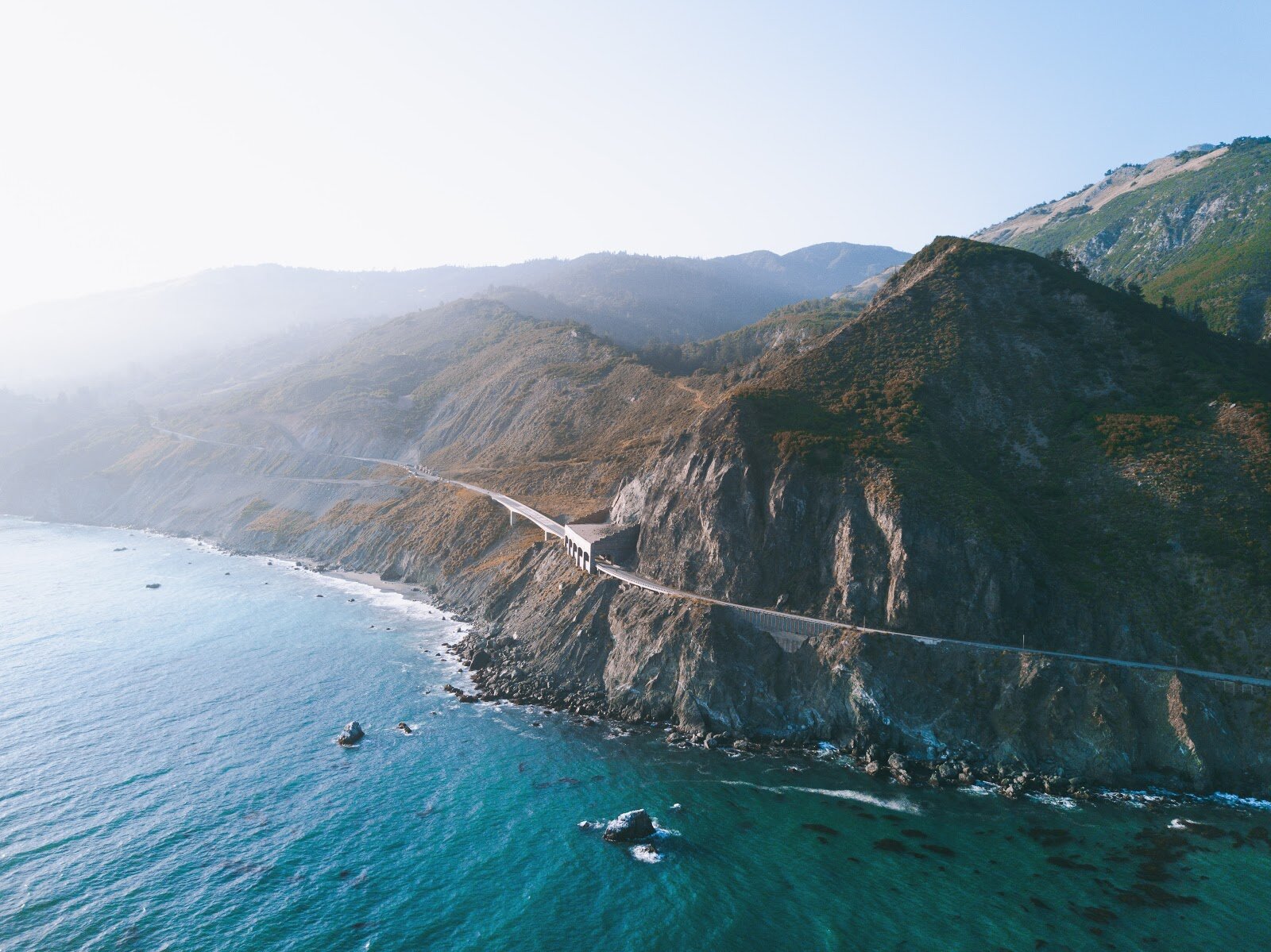
Photo by Thomas Ciszewski via UnSplash
Big Sur Camper Van Road Trip
Big Sur is one of the most beautiful and rugged stretches of coastline in the world, and it’s located only 2-3 hours south of San Francisco. The drive along Highway 1 down to Big Sur is beautiful in its own right, and there are plenty of things to do and see along the way. Big Sur’s easy accessibility from the Bay Area, its breathtaking beauty, and its endless list of sights and activities make it one of our favorite weekend camper van trips from the SF Bay.
Highway 1
If you take Highway 1 south from San Francisco to get to Big Sur, there are several attractions along the way that are worthy of a pit stop. If you like to break up your drive and take your time along your route, check out these areas on your way down to Big Sur:
Half Moon Bay
Half Moon Bay is just a short drive south of San Francisco on Highway 1. This quaint little coastal town features great beaches, world-class surfing, beautiful hikes amongst coastal redwoods, and convenient camping. If you pass through during a winter swell, be sure to check out Mavericks, where you can get a view of some of the world’s best big wave surfers riding massive waves.
Santa Cruz
Santa Cruz is a well-known city situated on the north side of Monterey Bay. With great restaurants, gorgeous beaches, amazing surf, and world-renowned hiking and mountain biking, Santa Cruz is an outdoor enthusiast’s dream city. Stop and have dinner on your way back home, or visit the Beach Boardwalk with your kids.
Sprinter Van Camping in Big Sur
There are plenty of great camping options once you make it down to Big Sur. Fernwood Campground, Plaskett Creek Campground, and Kirk Creek Campground all offer tent sites with parking that will fit a camper van and basic amenities like bathrooms and running water. Of the three, Kirk Creek is the most sought after, as it is the only campground in Big Sur located on the western (ocean) side of the highway. Most campgrounds in Big Sur offer a mix of reservation only and first-come-first-serve campsites, so an impromptu trip down the coast isn’t out of the question.
If you prefer free dispersed camping, head up Nacimiento Fergussen Drive, which is a paved road that features several pullouts where you can spend the night. There are also incredible vistas along the road, so try to catch a sunset up here, if you can.
What to Do in Big Sur
Okay, Big Sur is beautiful, but what is there to do there? We know the Bay Area Sprinter van community is an active bunch, and fortunately there are plenty of opportunities for outdoor recreation to keep you busy while in Big Sur. Below are some of our recommendations for what to do while you’re in the area.
Cycling
Whether you are a mountain biker or you stick to the pavement, Big Sur offers some incredible trails and roads to spin the gears on. Highway 1 offers legendary views and challenging climbs for experienced road cyclists, while mountain bikers will enjoy the plethora of trails in the area such as the Rocky Ridge Trail and Old Coast Road.
Hiking
Big Sur offers a lifetime’s worth of hiking trails, and most of them are stunningly beautiful. For an easier jaunt that features a beautiful waterfall, check out the Overlook Trail to McWay Falls. For a longer hike, the Timber Top and Boranda Trail features breathtaking views of the Big Sur coastline and is about 5 miles in length.
Surfing
The surf in Big Sur is remote, cold, and rough – but experienced surfers who are willing to brave the conditions can be rewarded with excellent waves and entire breaks to themselves. The north end of Molera Beach features one of Big Sur’s more popular breaks, while Willow Creek offers a more secluded setting.
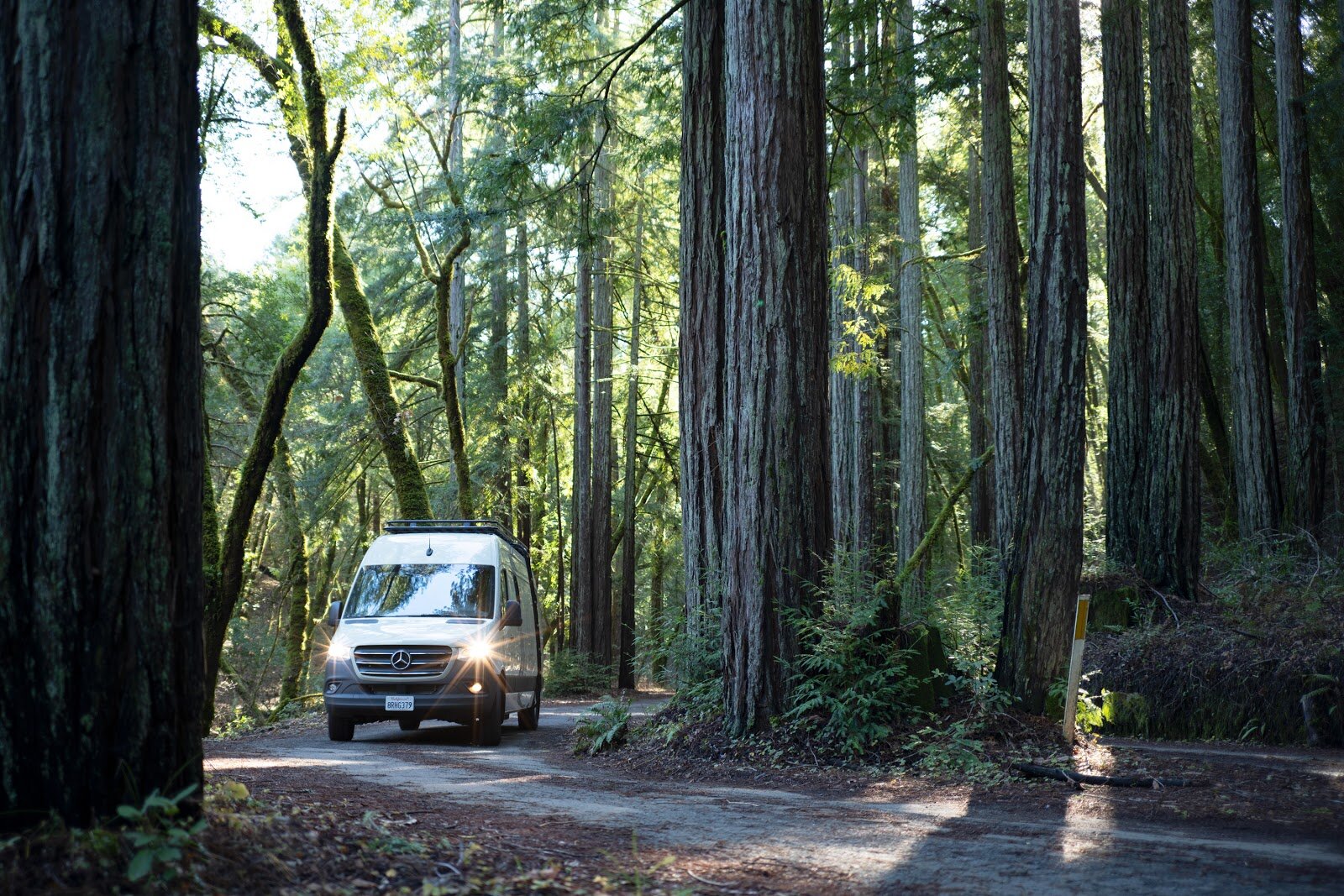
Photo by Muse & Co. Outdoors
Tahoe Camper Van Road Trip
The Lake Tahoe basin and the surrounding mountains and forests are home to some of the most beautiful scenery in the United States. “Tahoe” encompasses a large area of the Sierra Nevada Mountains, stretching from areas around Truckee, several miles north of the lake, south to Kirkwood and the Highway 88 corridor.
With incredible views, plenty of dispersed and developed camping, and endless ways to get outside and enjoy the land, Tahoe is a Sprinter van owner’s dream. Plus, many of the best places to play in Tahoe are within 3 hours of the Bay Area! Below, you’ll find our camper van guide to Tahoe broken down into 3 of Tahoe’s best areas to recreate.
Truckee/Donner Area
Truckee is a small town located about 20 miles north of Lake Tahoe, but locals and visitors alike consider Truckee to be part of the greater Tahoe area. Truckee has its own large alpine lake, Donner Lake, where you can engage in many of the same summer activities you might find yourself doing on Lake Tahoe.
Nearby Northstar-at-Tahoe and Sugar Bowl ski resorts offer great skiing in the winter and mountain biking during the summer. Donner Pass holds a massive amount of excellent rock climbing and hiking. The town of Truckee is small and quaint, with several restaurants and shops in its downtown area.
Sprinter Van Camping Near Truckee
There are an abundance of places to camp near Truckee, including both established and off-grid campsites. For established camping with amenities like a bear box, fire pit, bathrooms, and showers, our top choice is Donner Memorial State Park Campground. The campsites are nestled amongst the pines on the eastern shore of Donner Lake, putting you just minutes from downtown Truckee, the I80 corridor, and the lake’s shore.
Truckee is surrounded by national forest on all sides, with virtually endless fire roads and pullouts worth exploring. If you like the solitude and adventure of off-grid camping, you should have no trouble finding a great spot within 20-30 minutes of town. Those with 4WD Sprinter vans will be able to access spots down some of the rougher dirt roads in the area.
Around the Lake
Although generally more crowded, it’s hard to argue against wanting to stay in the immediate vicinity of Lake Tahoe itself while you’re in the area. You can get astounding views of the lake’s crystal blue waters and surrounding mountains from all of its shores. Tahoe’s most developed areas lie on the lake’s north and south shores, so if you want to stay closer to civilization, those areas are good bets.
Ski areas like Heavenly, Homewood, and Diamond Peak are all within a few miles of the shoreline and offer astounding views of the lake while you ski. During the summer months, check out the beaches and hiking near Emerald Bay on the southwest corner of the lake, then head to South Lake Tahoe for a beer at one of the local breweries.
Sprinter Van Camping Around Lake Tahoe
The areas directly surrounding Lake Tahoe are generally more developed than other regions of the basin. Moreover, the undeveloped areas tend to fall on state park land, rather than national forest. This means that dispersed, off-grid Sprinter van camping is hard to come by around the lake.
Not to worry though, the plethora of state parks means there are several developed campgrounds to choose from, many with sites that are within walking distance and offer views of the lake. If you can plan far enough in advance, we recommend snagging a site at D.L. Bliss State Park Campground on the lake’s west shore. When you choose a site, take a look at the campground map to see which sites are closest to the water. There are some sites with truly stunning vistas that are a stone’s throw from Lake Tahoe’s shores!
Highway 88/ The Kirkwood Corridor
The Highway 88 corridor is one of the most wild and uncrowded areas near Lake Tahoe. For those who like to avoid the crowds and really get out and explore, a trip to this area makes for a great long weekend away from the hustle and bustle of the Bay Area.
During the winter, Kirkwood Mountain Resort offers some of Tahoe’s steepest and highest elevation terrain, as well as plenty of easier terrain for all ability levels. During the summer, the surrounding area is a wonderland for bikers, hikers, fishermen, and climbers. This area is especially spectacular during early fall, when the numerous large aspen groves on either side of Highway 88 begin to turn.
Sprinter Van Camping Along Highway 88
Virtually the entire Highway 88 corridor runs through national forest land, which means that opportunities for off-grid Sprinter van camping abound. Get in touch with the local national forest offices to ask about dispersed camping in the area you want to go. There are many beautiful sites tucked just off the highway with minimal road noise and plenty of privacy.
You can also find several developed Forest Service campgrounds in this area. Our favorite is Kirkwood Campground, which offers running water, bathrooms, and bear boxes for food storage. Nearby Kirkwood Lake has great fishing and several hiking and biking trails.
Are you looking for a Bay Area Sprinter van conversion company? Muse & Co. Outdoors is a trusted builder based in Oakland, CA. Check out our models and find more information here!
Muse & Co. Outdoors Camper Van Electrical Systems Explained
Photo credit: Muse & Co. Outdoors
While the system is simple and designed to ‘just work’, it’s still a good idea to understand its ins and outs. That’s why we put together this guide, which details the electrical components that come standard in Muse & Co. Outdoors vans, describes the ways you can add onto and modify your system, and gives some basic guidance about what our systems can and can’t do.
Electrical Components in Muse & Co. Outdoors Camper Vans
The electrical systems in our vans are seamlessly integrated and essential to their comfort. They are responsible for several critical tasks, from keeping the fridge cold, to supplying running water, to charging devices like phones and laptops. We’ve hand-selected every component to ensure that the entire system is top-of-the-line. Below you can find a comprehensive list of the electrical components that are included standard in our van builds.
Batteries
The batteries are the actual power source in your van’s off-grid electrical system. Our vans come standard with four 100 amp-hour Relion lithium 12V batteries. Lithium is the gold standard when it comes to camper van batteries, and there are many reasons why.
You may have heard of builders using battery types other than lithium for their builds. Simply put, the only real advantage of other battery types is that the upfront cost is smaller. Lithium batteries are more expensive, but they outperform AGM and other battery types in just about every way.
Lithium batteries are way lighter than AGM, have about double the usable capacity, and have a much longer lifespan. In fact, if you consider the lifespan and replacement cost of AGM vs. lithium batteries, lithium is likely to be the cheaper option.
Loads
The loads of your Muse & Co. Outdoors van’s electrical system are all the things in your van that actually use electricity. Some of the loads are installed components of your van such as your lights and fridge. Others will be devices you charge and plug into one of the outlets in your van. The following 12V loads are included with every Muse & Co. Outdoors van:
- Dometic fridge
- Espar 12V Integrated Diesel Heater
- Shureflow water pump for on-demand running water
- Two bedside reading lights
- Eight recessed dimmable overhead lights
- Maxxair Maxxfan Deluxe Automatic Ceiling Vent with Remote
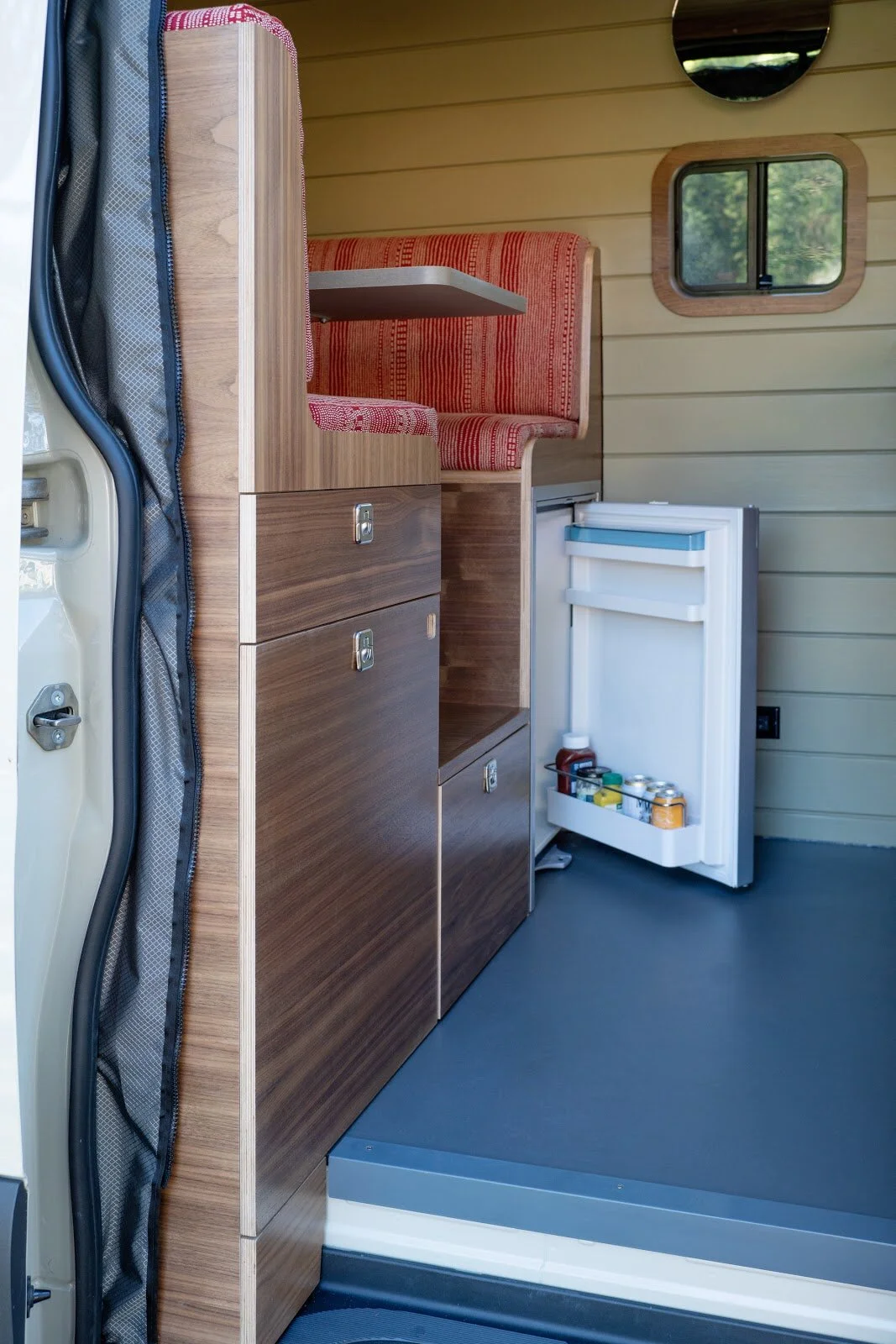
Photo credit: Muse & Co. Outdoors
- Xantrax Freedom XC 2000W Inverter with Panel-Mounted Controller
- Four Standard 110v Duplex with Integrated USB
- Dual DC Wall-Mounted USB Port
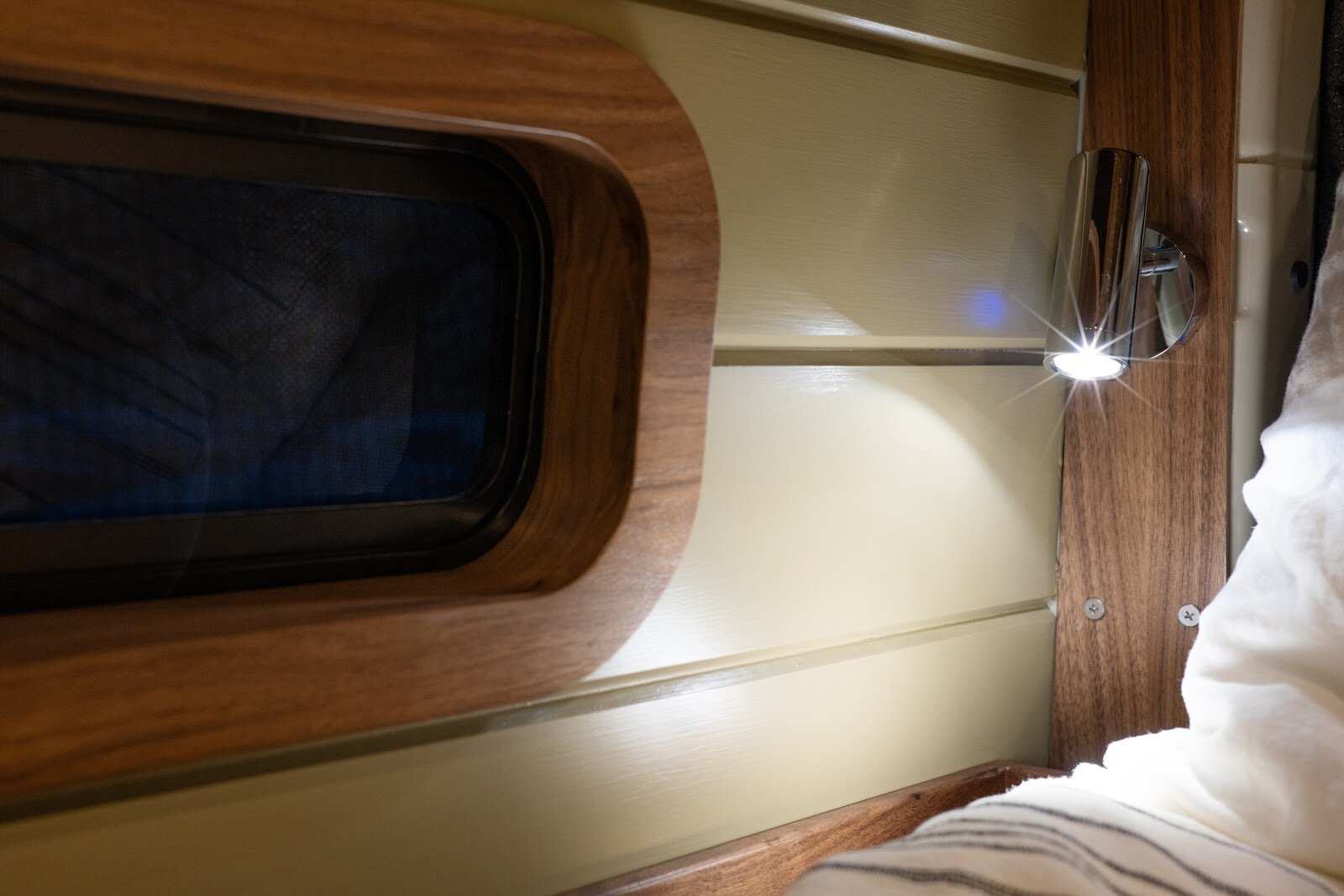
Photo credit: Muse & Co. Outdoors
Charging
Your lithium batteries have a finite amount of power available. In order to keep all of your loads running, your batteries must charge. Muse & Co. Outdoors vans utilize both solar panels and shore power to keep the batteries charged. This gives you a reliable way to charge your batteries, whether you’re parked in a friend’s driveway or deep on rural desert backroads. The charging components included in our vans are as follows:
- Four Roof-Mounted 100-watt Zamp Obsidian Solar Panels (Total of 400w)
- 30-amp Zamp Solar Charge Controller
- Four 100Ah Lithium Batteries
- Xantrax Freedom XC 2000W Inverter with Panel-Mounted Controller
- Waterproof 15 Amp 125V AC Shore Power Inlet
The solar panels and charge controller work together to keep your van batteries topped off wherever the sun shines. When you have access to shore power, simply run an extension cord from a normal outlet to the shore power inlet. Your Xantrax charger will use the shore power to top off your batteries, and the 110v outlets inside of your van will bypass the batteries. This means you can run larger appliances and use them without draining your batteries, as long as you’re connected to shore power.
What To Expect From Your Muse & Co. Outdoors Camper Van’s Electrical System
Our systems are sized and designed with your comfort and ease-of-use in mind. Under normal conditions, you should simply be able to run all of the included appliances, charge your devices, and run small 110v appliances for short periods of time – all without ever needing to think about the charge state of your van’s batteries. We’ve sized our systems with this type of use in mind.
Still, like any camper van electrical system, there are limitations. The most common mistake that people make with regards to their Sprinter van’s electrical system is assuming that they can plug in and run any 110v appliance at any time. In a Muse & Co. Outdoors van with our standard electrical system, you can use your 110v outlets to charge most devices, and power small appliances such as a pressure cooker or external monitor for a few hours at a time.
If you try to plug in and run devices that draw a higher wattage than the inverter (1000w) is capable of providing, they won’t work. And, if you run devices with a power draw that is at or near the inverter’s maximum for an extended period of time, you will drain your batteries very quickly. Remember, however, that if you are plugged into shore power, you can use your van’s 110v outlets as you would at home.
Available Add-Ons
Some people require more from their van’s electrical system than the average traveler. We have customers that use their vans to travel long-term while working from the road. Others want to take extended trips in the dark and mossy forests of the pacific northwest, where solar energy is at a premium. Whatever the situation, Muse & Co. Outdoors offers upgrades for your van’s electrical system that will allow you to travel your way.
Available add-ons to your van’s electrical system are as follows:
- Alternator Charger: An alternator charger takes energy from your van’s motor to charge your batteries while you drive down the road. Although solar charging will be adequate for many travelers, it can be nice to have a backup charging source. Alternator chargers are a must-have for people who plan to camp for extended periods in dark areas. They can also come in handy if you’re traveling during winter and your panels get covered in snow.
- Inverter Upgrade: You can opt for a larger inverter in your van if you wish. A larger inverter will allow you to run 110v appliances that have a high power draw off-grid. Still, remember that doing so, especially for extended periods, will drain your batteries quickly. If you’ve just got to bring that Vitamix or toaster along on the road, a larger inverter may come in handy.
- Battery Status Screen: If you’d like to keep an eye on your batteries’ state of charge, we can add a battery status screen to the inside of your van. The screen will show you what percentage of your battery power has been used up, and you can watch the batteries fill up as they charge.
If you have any additional questions about the electrical systems in Muse & Co. Outdoors vans, don’t hesitate to give us a call. We’re always here to talk and answer any questions you might have!
The Truth About Campervan Electrical Systems
Photo credit: Muse & Co. Outdoors
A lot of people find Sprinter van electrical systems to be a confusing topic, but they don’t have to be. You don’t have to be an electrician to understand your camper van’s power system. In fact, many beginners build their own DIY campers and tackle the camper van electrics themselves! In this article, we’ll outline the basics of Sprinter van electrical systems, from how they work, to what they can and can’t do. Keep reading to learn more!
How Camper Van Electrical Systems Work: The Basics
Camper van electrical systems have three main parts: The power source, the charging source, and the loads. Any basic wiring diagram for a camper van electrical setup will show these three components. Below, we break down each of these electrical components and explain how they fit into the system as a whole:
Power Source
Camper van electrical systems are almost always 12-volt DC systems, so they use 12-volt DC batteries as their power source. The “leisure batteries” that are used to provide electricity in your van are similar to car “starter batteries”, but they are specifically designed for the type of use that is common in camper vans.
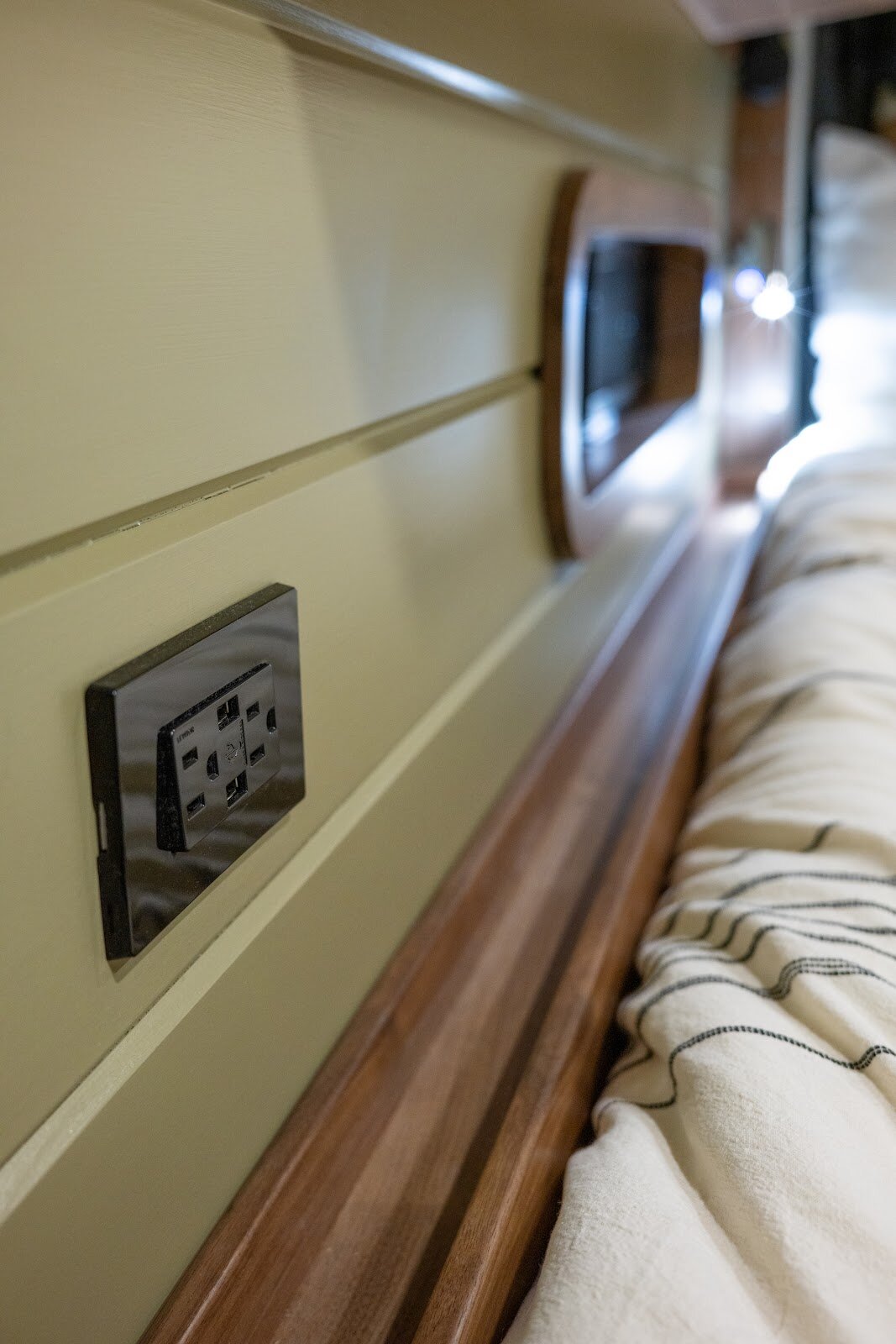
Photo credit: Muse & Co. Outdoors
Batteries vary in how much electricity they store, and it is common in camper vans to use anywhere from one to four or more, depending on what size battery they use. Storage in camper van batteries is measured in “amp hours”. The more battery capacity you have, the longer you can use the electricity in your van before needing to recharge the batteries. You should install a battery monitor in your van to keep track of how much power you have remaining at any given time.
Your camper van will be considered a 12V system, because the batteries you have will provide 12V DC power. 12V DC is different from the 110 or 120V AC power that you can access through the outlets in your home. 12V DC is common in RVs, boats, camper vans, and more.
All this means is that the loads you hook up in your camper van, such as your lights, fridge, and fan, must be 12V appliances. Anything that is meant to plug into a home electrical outlet, such as your blender or computer charger, requires AC power. It is possible to provide AC power through outlets in a van, but there are limitations to what can be powered. We’ll cover this topic in more detail in the ‘Loads’ section.
Charging Source
Your batteries will power all the loads in your camper van, but as they do so, they become depleted. Unless you have a way to charge the batteries, you will run out of electricity in your van. You don’t have to have only one charging source for your batteries; you can use multiple sources to charge them faster and ensure you have a backup plan if one isn’t working
The three most common ways to charge camper van batteries are:
- Solar panels: It’s rare to see a new camper van build these days without solar panels on the roof. Solar is a great way to charge your van’s batteries wherever the sun shines. Most camper van electrical systems can rely mainly or entirely on solar power to charge the batteries. Your solar system will also require a solar charge controller to be used for battery charging. The more solar panels you have, the faster they will charge your van’s batteries.
- Alternator charging: Ever wonder how your car battery gets recharged? It does so using the vehicle’s alternator, which converts power from your engine into electricity to charge your car battery. Your Sprinter van has an alternator, and it can also be used to charge the auxiliary batteries that you use for camping. There are a few devices that can be installed to transfer power from your van’s alternator to your batteries, including split charge relays. All of them require the van to be running in order to charge, and will charge faster while you’re actually moving down the road.
- Shore power: You can also charge your van batteries by ‘plugging them in’ to an outlet in a house or elsewhere, like at a campsite with electric hookups. To charge 12V batteries in this manner, you need an AC to DC battery charger, which is a common addition in camper vans. Then all you need is an extension cord, and you have a reliable charging source for your van batteries whenever you are in a driveway or at an RV park. It is also possible to bypass your van batteries when plugged into shore power (also called a “mains power supply”), meaning you can have outlets in your van that are powered directly from the grid. This allows you to run high-load appliances while plugged into shore power that you can’t use while camping off-grid, and it also lets you use the outlets in your van without draining your batteries.
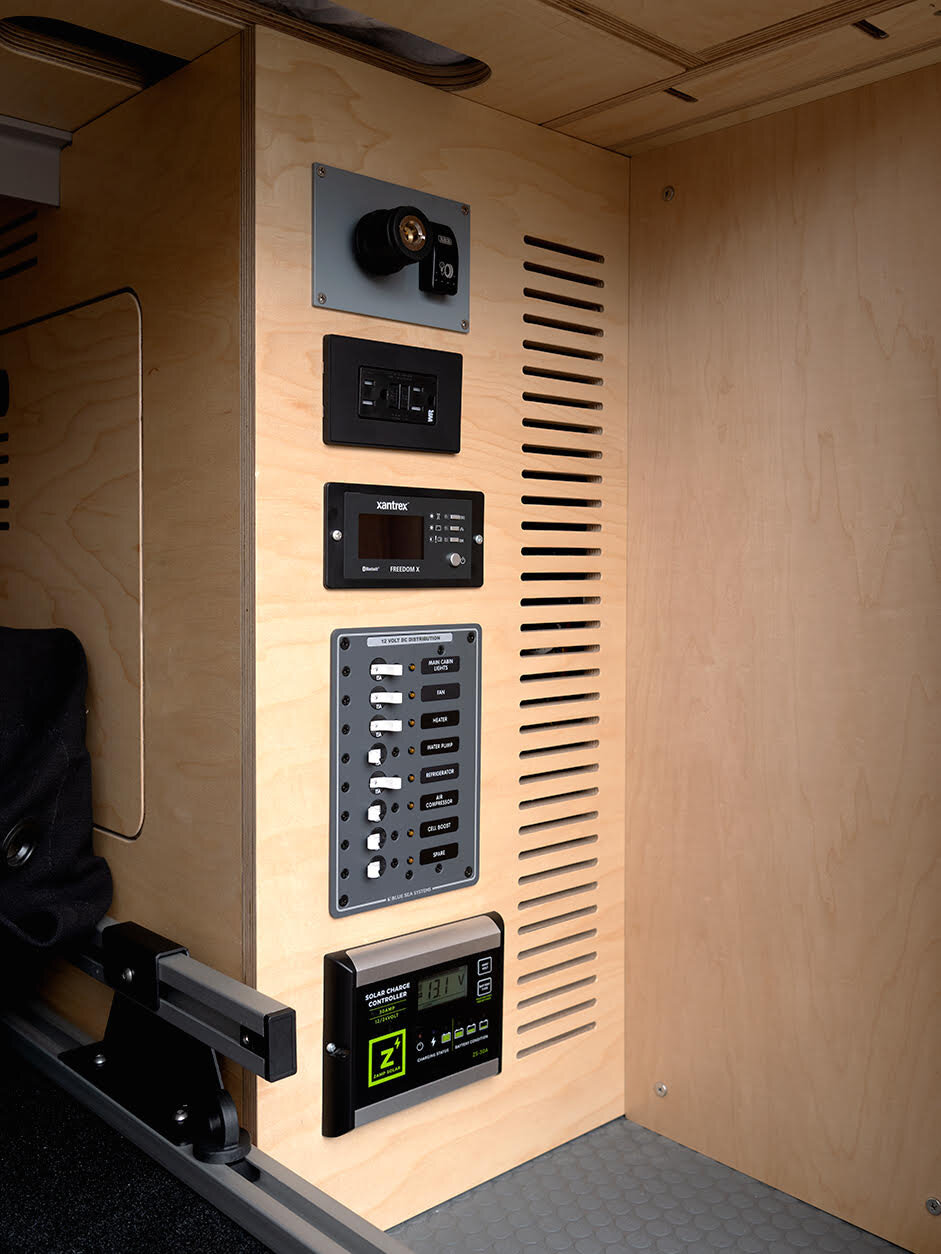
Photo credit: Muse & Co. Outdoors
Loads
The loads of your camper van electrical system are all the things that you actually use in your van that require electricity. Common loads in a van include LED lights, a fan, a heater (which requires electricity to run but uses diesel or propane to actually provide heat), water pumps, a fridge, and 120V outlets for charging devices, etc.
Above, we mentioned that your camper van’s batteries provide 12V DC power. All of the appliances in your van, such as your lights and fridge, use 12V DC power – so they can simply be wired to the batteries to power them. If you want to charge devices and use small household appliances that plug into a regular household outlet, you need what’s called an inverter.
Inverters come in two main types, pure sine wave and modified sine wave. For most camper van systems, you’ll want a pure sine wave inverter as they can charge laptops without damaging them.
Inverters take the 12V DC power from your van’s batteries and convert it into 120V AC power, which is what comes through the outlets in your house. The main difference is that the outlets in your house are powered by the local power grid, which provides a virtually infinite source of electricity. The outlets in your van are powered by your batteries, which are a very limited source. This means that certain appliances just can’t be used in a camper van electrical system, because they drain the batteries too fast.
Inverters are useful for charging items like laptops and cell phones and powering small appliances like blenders.
Other Components
You charging source, batteries, and loads are the three main components in your camper van electrical system. But many other smaller components are also critical to making the system work.
The following smaller components are likely to be included in your van’s electrical setup:
- fuse box
- fuse holders
- battery isolators
- wire connectors
- negative and positive bus bars
- different wire gauges
Reality Check: The Limitations of Camper Van Electrical Systems
Having electricity in your van is a big part of what sets it apart from just camping. A fridge is so much better than a cooler, and overhead lights are infinitely nicer than a headlamp. But your entire camper van electrical system runs off of a handful (at a maximum) of batteries. As a camper van owner, you need to understand the limitations of your rig’s system to ensure that you don’t damage it or run out of electricity.
The two main mistakes that van owners make when it comes to their electrical systems are draining their batteries completely, and trying to use plug-in household appliances that require too much electricity. Every system is built to different specs and will be capable of handling different loads, so if you aren’t sure about what your van’s system is capable of, contact the builder.
In general, you can avoid issues with your camper van electrical system by monitoring the charge state of your batteries and avoiding the use of large household appliances. In certain situations, it might be necessary to go a bit out of your way to ensure that your van’s batteries stay charged. Examples include moving your van into the sun or taking a short drive if your batteries are low and you are relying on either solar or alternator charging.
Your inverter’s wattage rating will determine the maximum current you can draw through your van’s 120v AC electrical outlets when camping off-grid. But even if you are using an appliance that is below the maximum wattage allowed by your inverter, you can drain your batteries very quickly when using the 120v outlets. Certain appliances, such as space heaters, hot water kettles, and hair dryers, should be avoided entirely in camper vans. Your inverter won’t allow appliances over its maximum wattage rating to work, but you also shouldn’t run appliances near or at the limit for extended periods of time – because they will drain your batteries extremely quickly.
If you plan to have increased power needs in your van, you should talk to your builder about sizing up your system. The best way to accommodate a larger power draw is to add a larger battery bank. In certain scenarios, it may also be helpful to add greater charging capacity in the form of more solar panels or an alternator charger.
A Note About Air Conditioning
You may have seen camper vans that have a rooftop A/C unit installed. While there are A/C units available that run off of 12V DC power, it is highly impractical to build a camper van electrical system that is capable of running an A/C unit while camping off-grid. Most of the vans you see with A/C units are only able to use them when plugged into shore power.
The power draw of a rooftop air conditioner is simply too large to be accommodated by an off-grid camper van electrical system. The number of batteries and solar panels that would be needed to reliably use the A/C unit off-grid would take up an impractical amount of space in the van. If you plan on camping mainly at RV parks or in driveways where shore power is available, you could consider installing an A/C unit on your van’s roof.
We hope this article helped you clear up some of the most common questions about camper van electrical systems! To learn more about Muse & Co. Outdoors’ systems, head over to our details page. And, keep an eye out for our next post in this series, which will explain in detail what is included in our vans’ electrical systems, and what options are available to add on.
Safety Tips for Camper Van Travel
Photo credit: © Muse & Co. Outdoors
Don’t freak out and cancel your plans quite yet, though–there are some simple things that you can do to travel more safely in your Sprinter van. In this article, we’ll break down some of our favorite camper van safety tips, including safe COVID-19 travel advice, how to pick safe spots to sleep, and what to bring along when you camp off-grid.
Camper Van Travel During the COVID-19 Pandemic
At the time of writing this article, the COVID-19 pandemic is still raging out of control in the U.S., with a new record high in daily deaths being recorded just yesterday. Hopefully, by the time you’re reading this, the situation is much more under control! But since we are likely to be living with this virus, in one capacity or another, for some time yet to come, it’s a good idea to know how to travel safely during a pandemic.
The good news is that traveling in a Sprinter camper van is one of the safest ways to hit the road during the pandemic. By nature, a camper van is like your own little isolation pod, complete with everything you need to be self-sufficient. Still, following these simple tips and guidelines help you further reduce your risk of contracting or spreading the virus:
Follow local guidelines and restrictions. First and foremost, you should always follow the current COVID-related guidelines and restrictions that are in place in your area of travel. This includes wherever you are coming from, as well as your destination(s). Local COVID restrictions are put in place by officials based on science and current infection rates, and they exist to protect you and others.
Minimize stops. Minimizing your stops is a critical part of COVID-safe travel. Aim to get all your groceries and supplies in one trip, before you leave. If you have to stop for gas, be sure to sanitize your hands before and after touching the pump. Minimizing the number of stops you take as you travel goes a long way towards protecting both you and the communities you pass through.
Make plans, and backup plans. Now is a good time to make a plan for where you will sleep each night and what activities you will engage in during the days of your trip. Try to choose areas that are less crowded. If you’re planning to camp off-grid somewhere that reservations aren’t possible, make sure you have a backup plan in place. That way, you can avoid overcrowding an area if there are already people camping there. The same goes for daytime activities where social distancing isn’t possible.
How to Find Safe Places to Park in Your Camper Van
Although camper vans provide more of a barrier between you and the outside world than tents do, some travelers are apprehensive about sleeping in a vehicle. Moreover, camper van travelers often find themselves camping out in unorthodox areas. Few vanlifers haven’t spent nights at Walmart parking lots close to the interstate, or highway pullouts just a stone’s throw from the morning surf spot.
The ability to camp comfortably in these areas is one of the major benefits of #vanlife. But it’s important to pick wisely and follow these basic precautions when choosing a place to settle down for the night in your Sprinter van:
Make sure it’s legal. The first thing you should always do when choosing an impromptu place to sleep for the night in your van is to make sure that it’s legal to camp there. For example, some (but not all) stores allow people to sleep in their vehicles in the parking lot. Walmart is famous among the camper van community as a go-to stop when you need a few hours of rest during a long drive. Similarly, some states and cities have regulations regarding sleeping in a vehicle. To avoid an unwanted knock on your van by police in the middle of the night, always heed these regulations.
Choose well-lit areas with an exit route. Well-lit areas are a better bet for safety. Anyone with bad intentions towards you or your property is much less likely to attempt to break into your van in a well-lit area. It’s also important to choose spots where driving away is straightforward. In a worst-case scenario where you feel unsafe in your spot, an easy exit strategy could make a big difference.
Don’t make yourself an easy target. The majority of van break-ins happen when crooks try to make a quick steal of a few valuable items. There are a couple of things you can do to minimize the chances of a break-in. First, always store valuables out of plain sight. Some full-time #vanlifers actually keep a safe in their rig. While this isn’t necessary for all travelers, it’s still a good idea to keep valuables well-hidden to discourage break-ins. Next, if you’re in a heavily populated area and you’re concerned about a break-in, you shouldn’t let potential thieves get a glimpse of what your van’s interior looks like. Exiting out the front doors, rather than the slider, is usually safer. Use window coverings or a curtain to block the view from outside. Most Sprinter vans without a view of the interior will look like just another cargo van to the average passerby.
Off-Grid Camper Van Safety Supplies
The ability to camp off-grid in remote areas is one of the unique benefits of camper van travel. But camping off-grid comes with a distinct set of risks, as well. Traveling several miles down remote dirt roads, often without cell phone service, means you’ll need to be extra prepared should something happen. With a few pieces of essential gear, off-grid camping in a Sprinter van can be safe as well as fun.
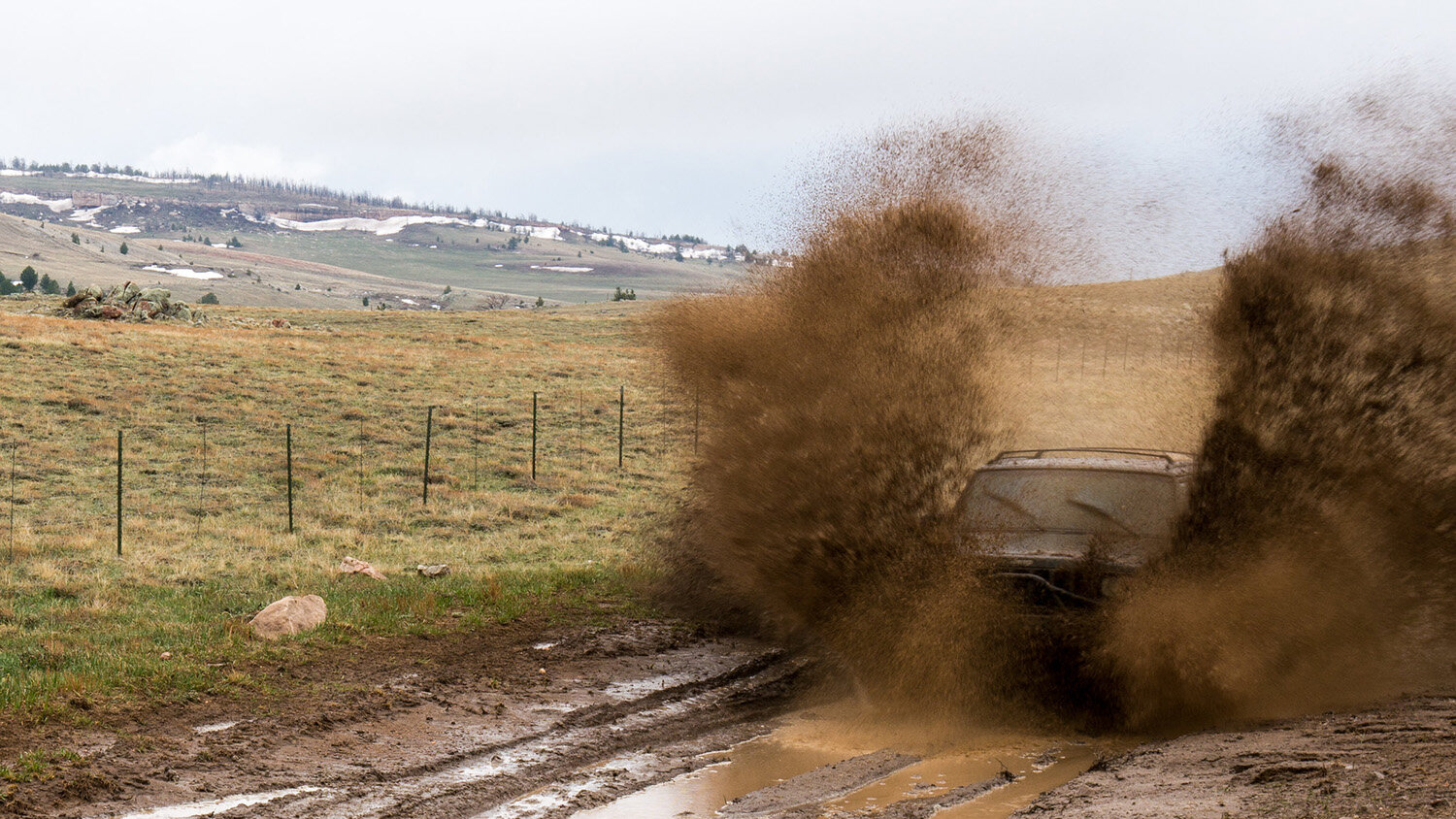
Vehicle Recovery Gear
If you’re camping in a really remote area, getting your van stuck just isn’t an option. Doing so could mean being stranded miles into the backcountry without cell service. That’s why some basic vehicle recovery gear is a must-have for anyone camping off-grid in their van. Bringing these items along should help you to stay out of trouble on dirt roads:
Traction boards: Traction boards can get you out of sticky situations on dirt roads quickly and easily. These super-strong boards made of high-strength plastic are designed to get you un-stuck if your tires are spinning out in areas of mud, sand, or loose dirt. To use them, you simply stick them under two powered wheels and hit the gas. Once you’re on more stable ground, you can retrieve them on foot.
Air compressor: An onboard air compressor allows you to inflate and deflate your van’s tires with ease. In areas of suboptimal traction, such as on sand, mud, or even snow, deflating your tires somewhat can greatly improve your traction. Of course, it’s bad for the vehicle and the tires to continue driving like this for long distances, so an onboard air compressor allows you to reinflate your tires when you are through the area of poor traction.
Camper Van First Aid Kit
A first aid kit is something you hope to never have to use. Still, in case of an emergency, it’s an essential thing to bring along during camper van travel. Many of the pre-packaged first aid kits you can buy in a drug store don’t include the true essentials you could need in an emergency situation. We recommend building your own camper van first aid kit, including the following supplies:
- Antiseptic wound cleaner
- Gauze
- Non-stick gauze pads
- Alcohol swabs
- Adhesive tape
- Antibiotic ointment
- Hydrocortisone cream
- Liquid bandage
- Ice packs
- Liquid Saline SOlution
- Ace bandage
- Surgical gloves
- Splints
- NSAIDS (Nonsteroidal anti-inflammatory drugs) i.e. ibuprofen, aspirin, etc.
- Bottle of purified water
- First aid manual
- Surgical scissors
- Pocket knife
- Sewing needle with heavy-duty thread
- Eye wash cup
- Tweezers
- Safety pins
As long as you bring along the right supplies, off-grid travel in a camper van can be worry-free. Keep these safety tips in mind during your next trip in your Sprinter conversion van. Camper van travel is meant to be fun and relaxing, and by taking these small precautions, you can enjoy your trip with peace of mind. Stay safe! Your friends at Muse & Co. Outdoors.
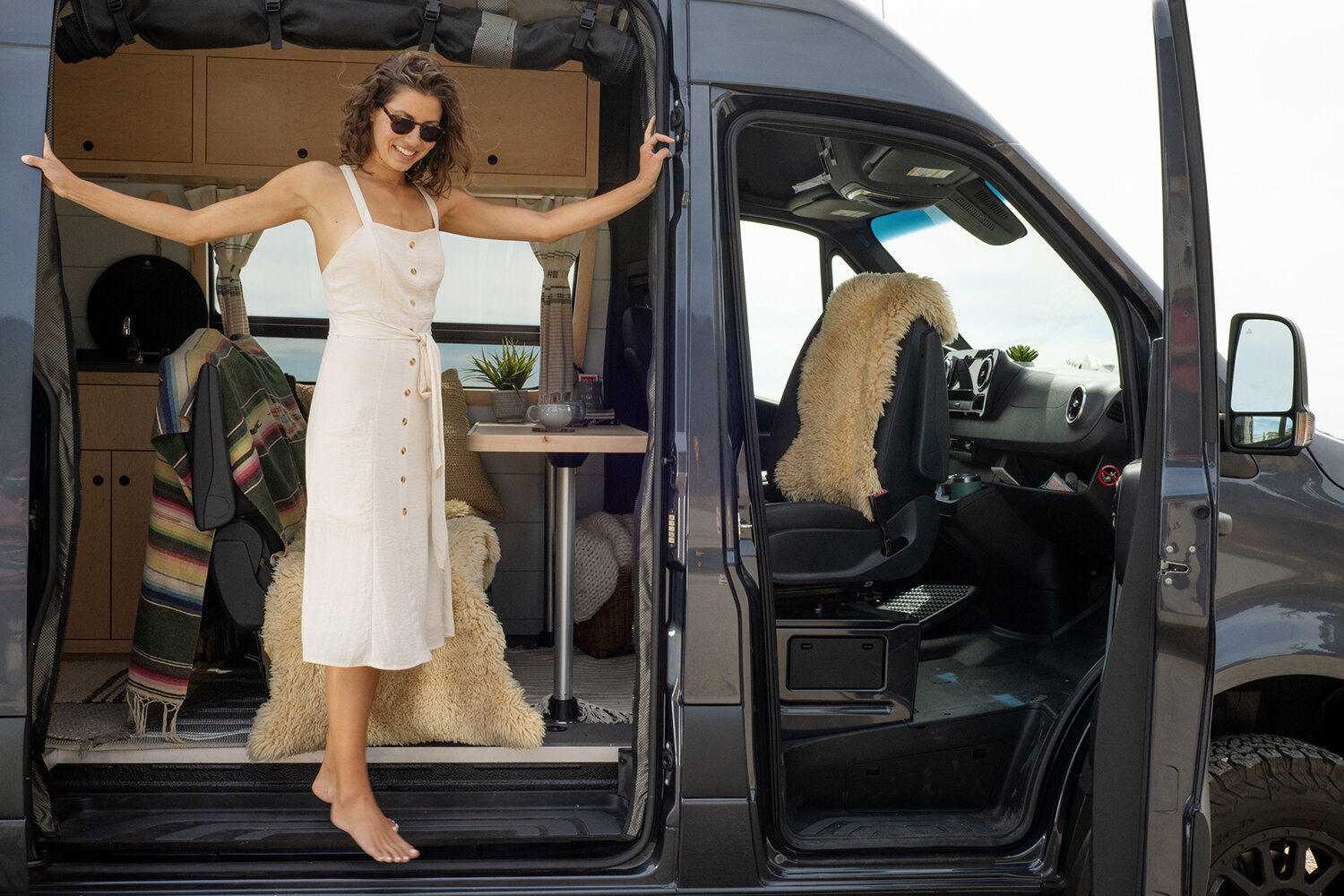
Photo credit: © Muse & Co. Outdoors
The Best #Vanlife Apps for Camper Van Road Trips
Photo credit: Geran de Klerk via Unsplash
But no matter how awesome something is, there’s always room for improvement. This is 2021, after all, so did you really think camper van travel was somehow separate from the wide world of tech? In fact, one of the easiest ways you can improve your Sprinter van road trips is to download a few nifty apps.
From helping you to find campsites off the beaten path, to ensuring you don’t spend too much on gas, using these apps can really take your camper van road trip game to the next level.
iOverlander
Best for: Finding campsites and boondocking spots.
iOverlander isn’t the sleekest app on this list, but its functionality is unparalleled when it comes to locating camping spots off the beaten path. The app uses a crowd-sourced method to add campsites and other helpful resources to their map.
Users who find great campsites in areas such as on BLM or National Forest land can add the site’s location to the iOverlander app, and include details and photos. People who visit the site can then add comments and photos to confirm that it is a legal, safe, and awesome place to camp!
In addition to campsites, the iOverlander map also allows users to add helpful locations such as hardware stores, mechanics, public showers, and places to fill a propane or water tank. These features can come in handy when you’re in unfamiliar territory and in need of supplies!
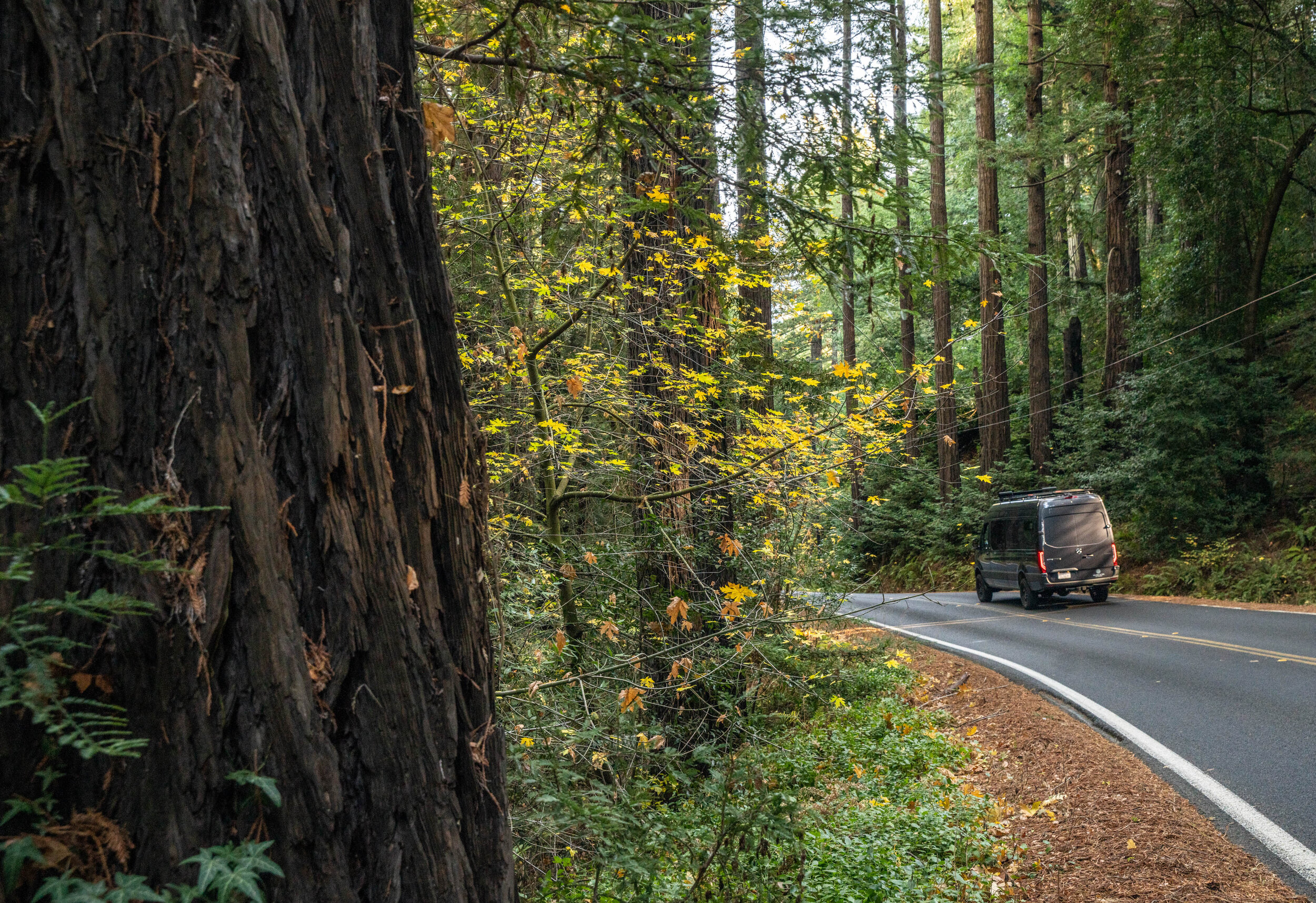
Photo credit: © Muse & Co. Outdoors
HipCamp
Best for: Private ‘glamping sites’ and other one-of-a-kind paid campsite opportunities.
HipCamp is an awesome app designed with Sprinter van travelers in mind. It’s commonly called the ‘Airbnb of #vanlife’, and it’s easy to see why. The app connects Sprinter camper van owners with a network of people offering unique, private camping opportunities on their land.
There are more than 300,000 listings on the site, so there’s a good chance that you can find a great option wherever you are traveling. Like Airbnb, hosts have a small bio detailing the available campsites on their land, and they receive ratings for their accommodations.
Unlike iOverlander, the HipCamp interface is user-friendly and easy to navigate. This is a great app if you’re looking for a unique, luxury camping experience.
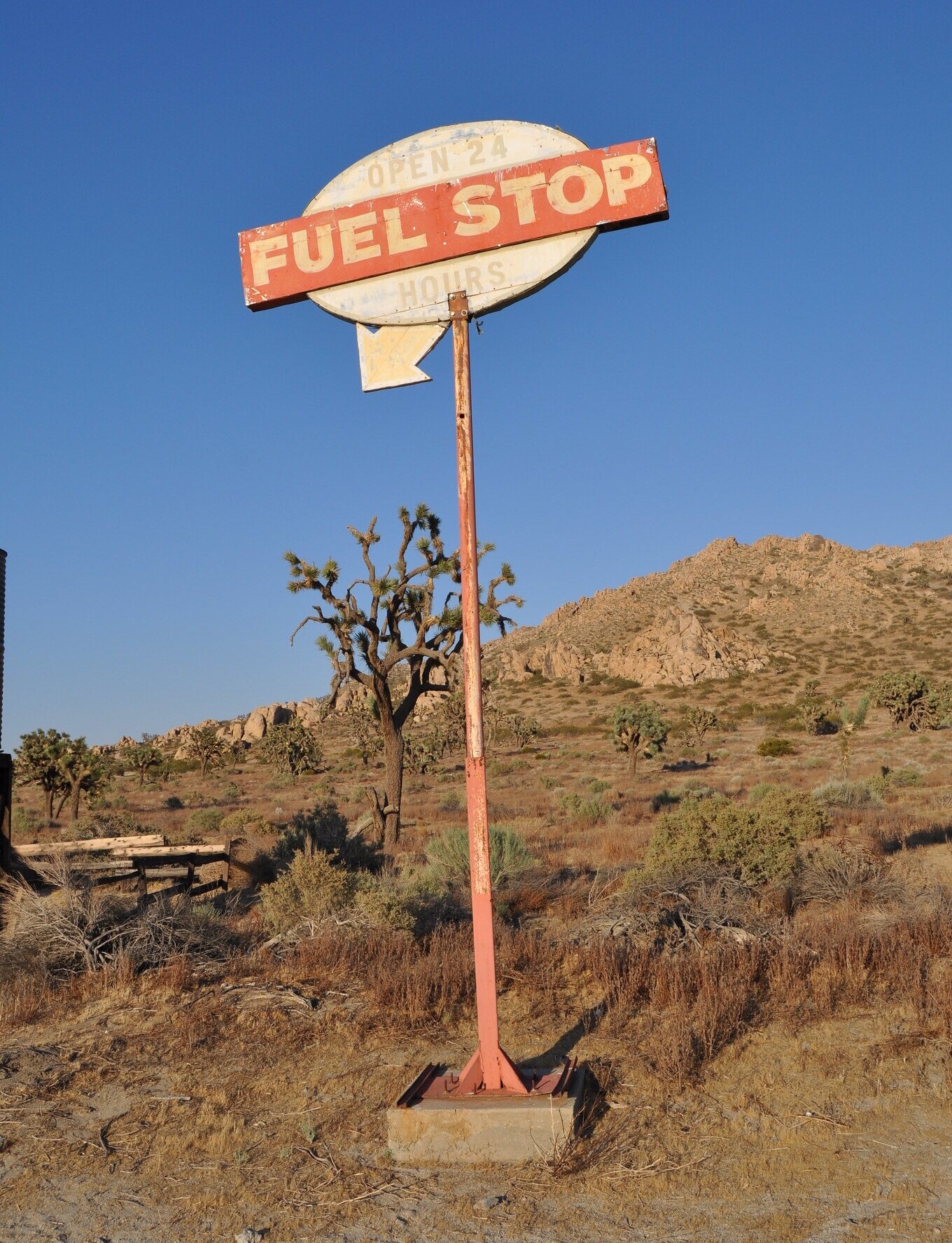
Photo credit: Club Ed filming location by Matthew Dillon is licensed under CC BY 2.0
Gas Buddy
Best for: Finding the best price on gas in your area.
Camper vans have many perks, but great gas mileage isn’t one of them. Although the diesel engine of a Mercedes Sprinter van is highly efficient, you’re still going to be getting mileage that’s in the teens.
There’s nothing more frustrating than stopping for gas on the interstate, only to pass a station five miles later with far lower prices. The Gas Buddy app helps you to avoid this situation and find the cheapest fuel in your area. The app also includes information on amenities offered at the station and allows users to leave reviews.
Make sure to heed the warning that appears when you open the app, and only operate your phone while your van is safely stopped–or have a passenger search for the best gas stations near you as you drive.
WiFi Map
Best for: Finding free WiFi hotspots near you.
WiFi Map is a great app for camper van travelers who need access to the internet. With so many people working remotely these days as they travel in their vans, this app is more relevant now than ever.
The functionality of WiFi Map is pretty self-explanatory: A variety of free hotspot locations, from hotels, to restaurants, to cafes, are pinned on an easy-to-navigate map. The app has more than 100 million users worldwide (!), and features around the same number of hotspots.
The app is free, but includes ads. If you opt for the paid version, the app is ad-free and includes a VPN service for better security when using public WiFi.
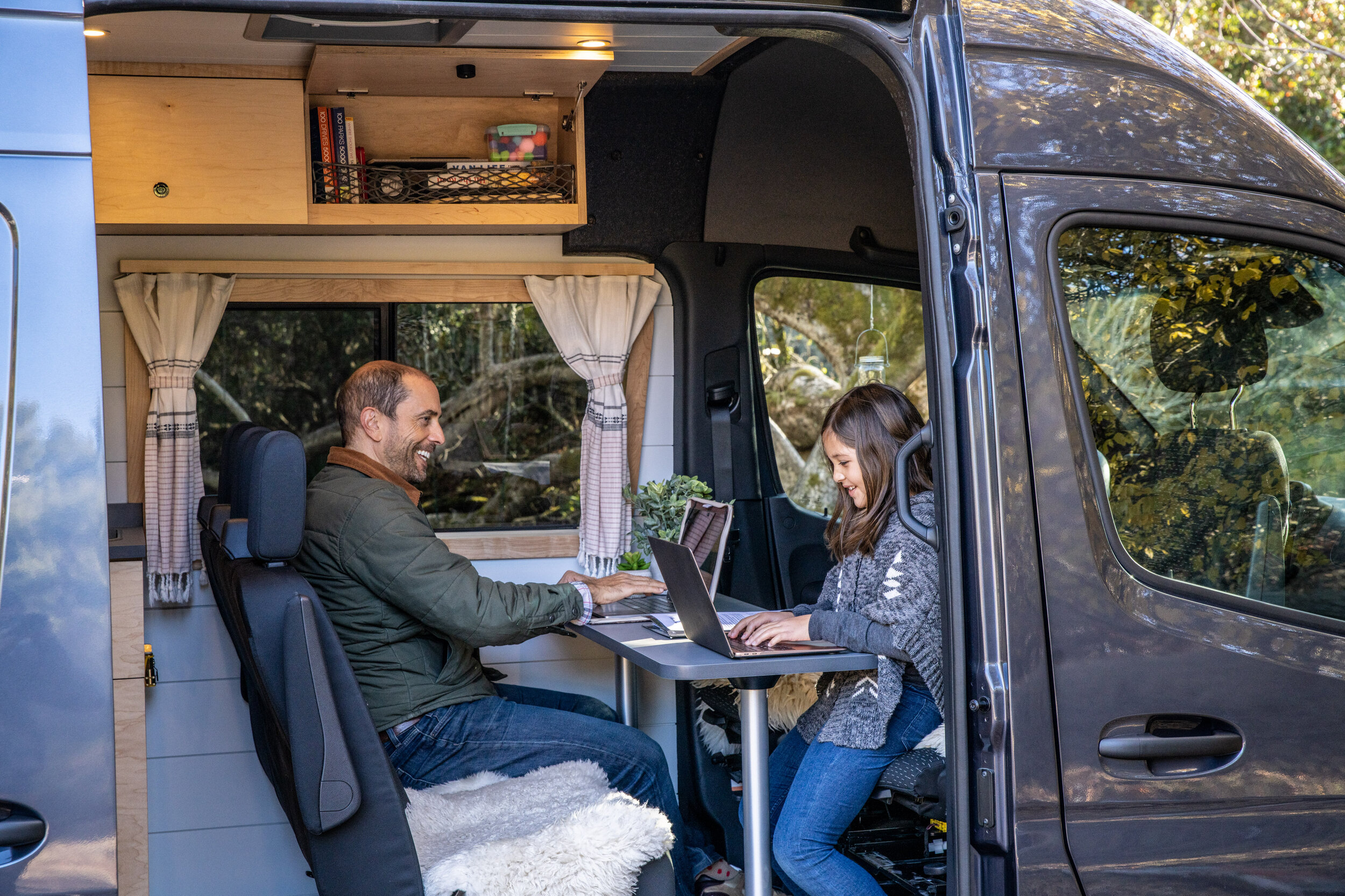
Photo credit: © Muse & Co. Outdoors
Journey
Best for: Creating journal entries on your phone or tablet.
Journey is a super-cool app which includes many features that #vanlifers are likely to find appealing. The app allows you to journal using a password-protected digital format. If you’re not totally attached to the old-school pen and paper way of doing things, Journey is worth checking out.
The app includes many awesome features that pair well with camper van road trips, such as the ability to add images, audio, and video to your entries. You can also tag the entries to a specific location on a map. If you journal consistently on a road trip, you can paint a beautiful and meaningful portrait of your experience using Journey!
The app boasts an aesthetically-pleasing user interface, and it is easy to navigate. Other features include a ‘mood chart’, where you can log and track your mood and see how it has shifted over the past month.
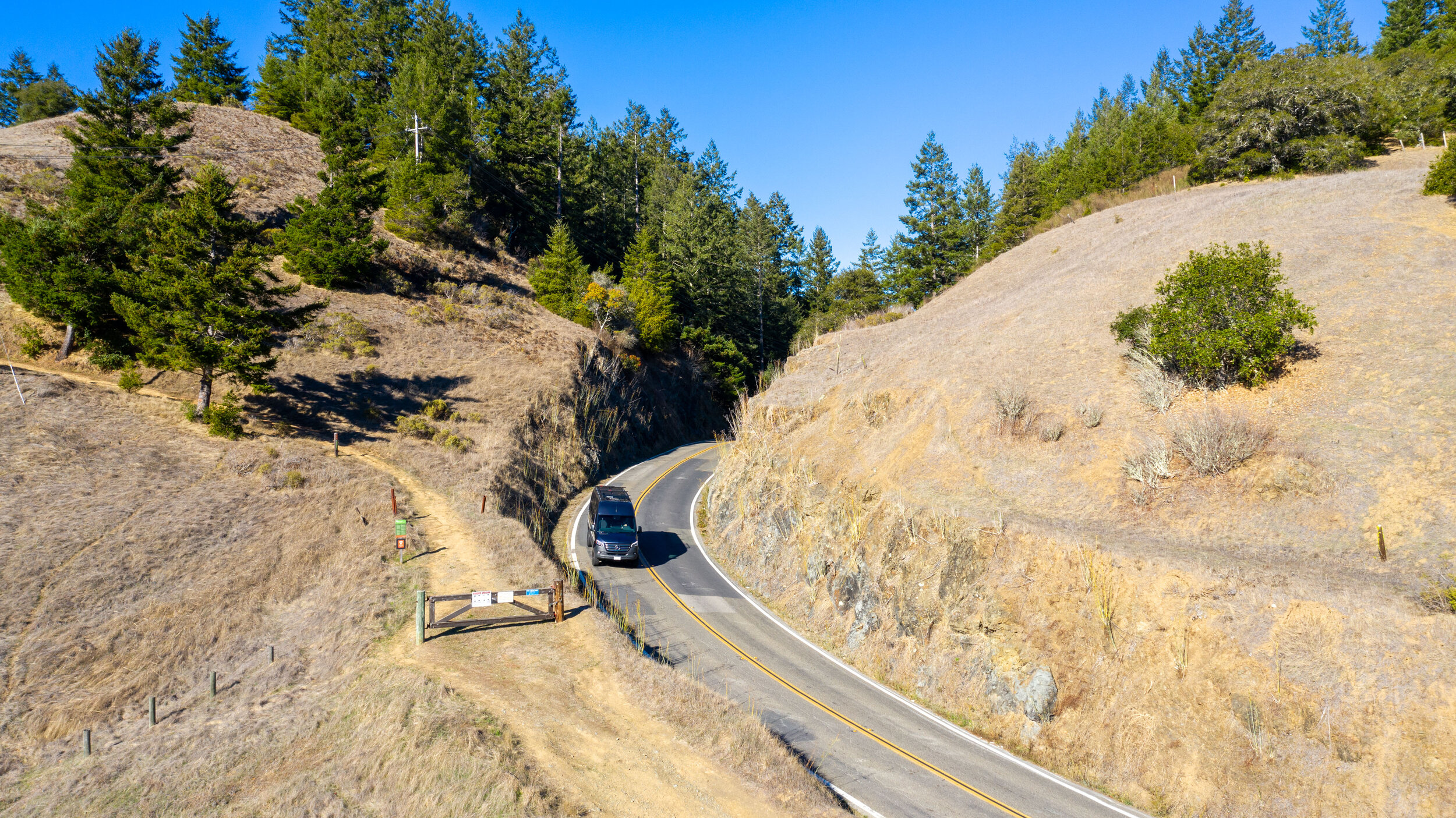
Photo credit: © Muse & Co. Outdoors
RoadTrippers
Best for: Planning a trip and finding cool things to do along the way.
Last, but certainly not least on our list of top #vanlife apps is RoadTrippers. This app is one of the most complex and featured on the list. Once you learn how to use it, you’ll wonder how you ever planned a road trip without it!
The app has two main features: a trip planner and existing trip guides. The trip guides are a fantastic way to find places to go and things to do, and you can even follow the guides exactly if you want a hands-off adventure.
The trip planning feature is where the RoadTrippers app really shines. You can start by adding a destination or two for your route. For example, say you want to visit Yosemite National Park and Lake Tahoe during a weeklong trip from the SF Bay Area. Once you add destinations to the map, the app gives you loads of helpful information such as how long your trip will take and how much gas should cost. It also shows you accommodations and activities that are easily accessible along your route and near your destinations.
RoadTrippers is free, but there is a paid premium version available that offers additional features such as offline maps, no ads, and live traffic maps. At Muse & Co. Outdoors, this is one app we can’t live without!
Why Is a Camper Van Conversion Better Than an RV?
Photo credit: © Muse & Co. Outdoors
So, what’s all the buzz about? What makes traveling in a Sprinter camper van so much better than their RV counterparts? In this article, we are going to dive into the camper van vs. RV debate and tell you why #vanlife is such a superior way to travel when compared to an RV.
Size DOES Matter…
We can all agree that the main difference between an RV and a Sprinter camper van is size. There are many other discrepancies between the two types of vehicles, but at the end of the day, all their differences come down to the fact that Sprinter vans are far more compact than their RV counterparts.
There are countless reasons, from fuel economy to maneuverability, why traveling in a smaller vehicle is advantageous, and we will get to those soon. For now, consider that Sprinter vans range from about 18 to 22 feet in length, while RVs are typically between 29 and 40 feet in length. Importantly, RV’s are also 2 to 3 feet wider and up to quadruple the weight of Sprinter camper vans.
Fuel Consumption
You might think bigger is better, but when it comes to the van vs. RV debate, there are many reasons why a more compact vehicle is advantageous. One prime example is the difference in fuel consumption between the two types of vehicles.
The 2020 Mercedes Sprinter boasts an impressive 14-17 mpg thanks to its super efficient and powerful diesel engine. On the contrary, a larger RV might get anywhere from 8-12 mpg depending on the specific model and size. When driving longer distances, this massive difference equates to a major discrepancy in the amount of money you spend on gas. Plus, burning more fuel is worse for this beautiful planet that we all love to roam and explore.
Camper Van Maneuverability
A major advantage of Sprinter vans is their maneuverability. These vans are originally produced with the intention of being cargo vans that are commonly used for inner-city transportation and delivery services. Their compact size allows you to easily drive them in the city, and many Sprinter camper van owners actually use their vans as their daily driver. Furthermore, you can park them on the street or in your driveway–saving you from the major cost of RV storage.
Sprinter vans’ maneuverability and compact size also come in handy when traveling and finding camping spots. While RV owners need to constantly be aware of where they are driving and whether they will be able to turn around, Sprinter vans don’t have this issue. Countless trailheads, vistas, and other exciting destinations are simply not accessible with an RV. Furthermore, Sprinters can fit into just about any camping spot, opening up a whole world of possibilities for camping beyond RV parks.
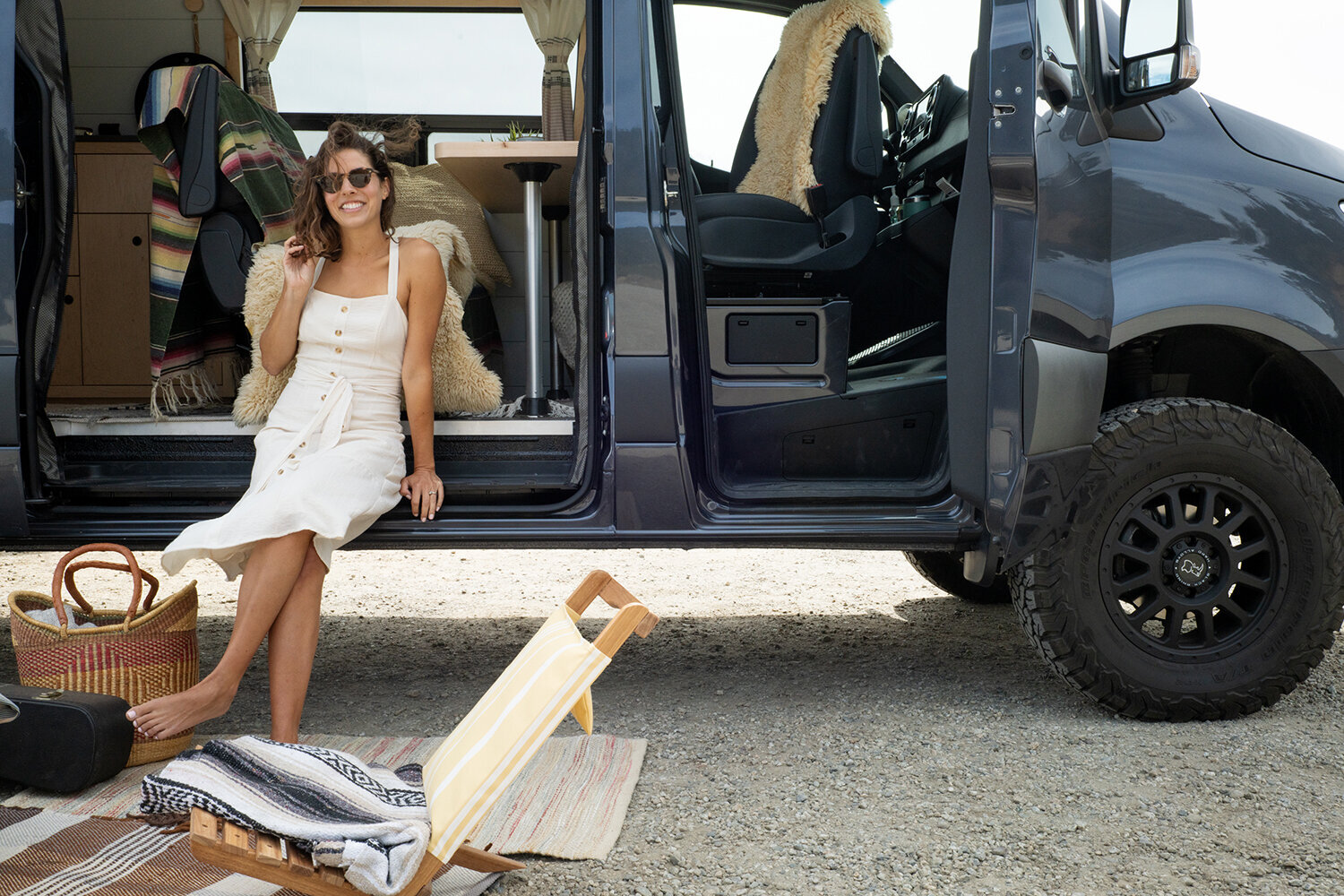
Photo credit: © Muse & Co. Outdoors
Off-Grid Capabilities
When you travel in an RV, you are pretty much limited to RV-specific campsites that have hookups and a large enough space to park your rig. But when it comes to camper van travel, the options for campsites are limitless.
We’ve all seen the incredible #vanlife photos of people relaxing in bed with their van doors open to a breathtaking view. The crazy thing is, these photos aren’t fantastical at all. Owning a camper van allows you to park and camp in places that RVs simply can’t go. There are many areas where ‘dispersed camping’ is allowed, including on BLM and National Forest land.
Most Sprinter camper vans are built with off-grid camping in mind. This means that they use charging sources such as rooftop solar panels to power the van’s electrical system. It also means that their water and propane systems are meant to handle trips in the backwoods.
Combining these features with the maneuverability and offroad capabilities of Sprinter vans (especially 4×4 models) makes for a truly badass off-grid camping machine. Sorry RV owners, your view of the RV park just isn’t any match for one of the Pacific Ocean.
Beautiful Custom Interiors
If you’ve ever actually stepped foot in an RV, you know there’s not much to write home about. Linoleum, cheap materials, and outdated color schemes are the name of the game when it comes to RV interiors. But the world of camper vans tends to have a different flavor to it.
Sure, there are still van builders out there who are pumping out cookie-cutter, RV-like van interiors–but many builders are using much more tasteful designs. Creativity and ingenuity are an integral part of the world of camper vans. The #vanlife movement gained popularity in large part due to viral photos and stories of travelers who built their own custom vans by hand. The best van builders have taken this concept and refined it, but the spirit of creating a little cabin on wheels is alive and well in the van world.
Here at Muse & Co. Outdoors, we build beautiful, hand-crafted van interiors using the highest quality materials and components. Our interiors speak for themselves, offering an elegant and understated space to relax after days spent outside. You get plenty of opportunities to customize your van’s look and feel. We can even work with you on an entirely custom build if that’s what you are looking for!
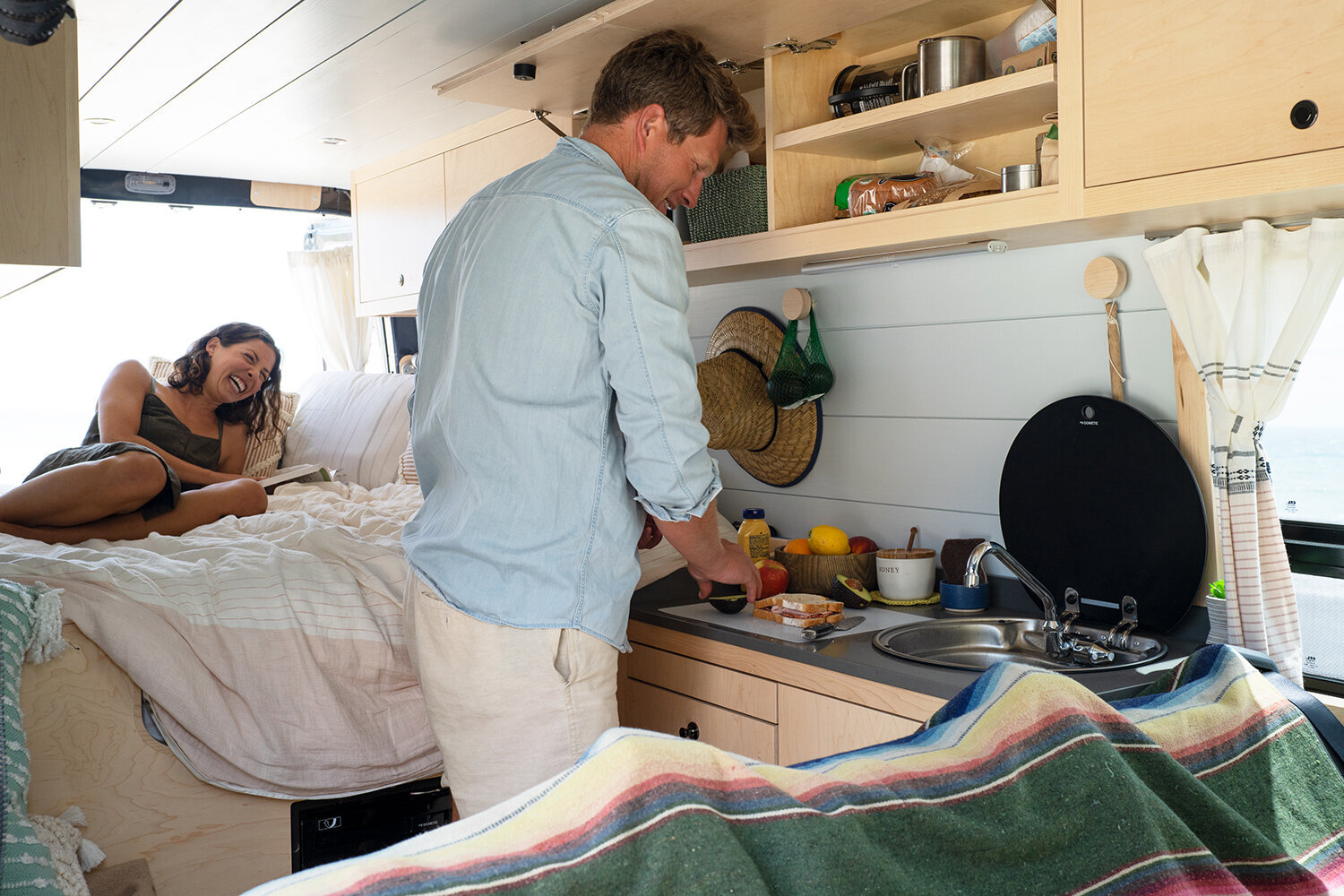
Photo credit: © Muse & Co. Outdoors
Camper Vans: Functionality Without Fluff
The fact is, RVs are way too big for what they actually offer. Camper van builders have developed ingenious ways of including many of the same comforts you would find in an RV, in a vehicle that comes with all the benefits of being much smaller.
Need a bathroom? No problem–A slide-out composting toilet and a rooftop solar-heated shower should take care of your needs. Want to cook? Most Sprinter camper vans include a fridge, a cooktop, a sink, and plenty of cabinetry. What about sleeping comfortably? Some vans, including all of our models here at Muse & Co. Outdoors, have room for a queen-sized, premium quality bed.
You can fit just about any luxury into a camper van, without the massive footprint of an RV. #Vanlife is all about stripping away the excess and taking along what’s truly important, but don’t be fooled–that doesn’t mean you can’t still be comfortable while traveling in a van.
Top 5 California Hot Springs to Visit in a Camper Van
Mammoth Hot Springs, Yellowstone NP, Wyoming by Carolannie is licensed under CC BY-SA 2.0
A Sprinter camper van is a fantastic way to travel the state, visiting hot springs along the way. The warmth of the springs and the minerals found in the waters can have a rejuvenating effect on the body and mind. The springs found in this guide range from remote pools with beautiful mountain vistas and free off-grid camping nearby, to fully developed springs where you can camp in your van and enjoy amenities like a bathroom and fire pit.
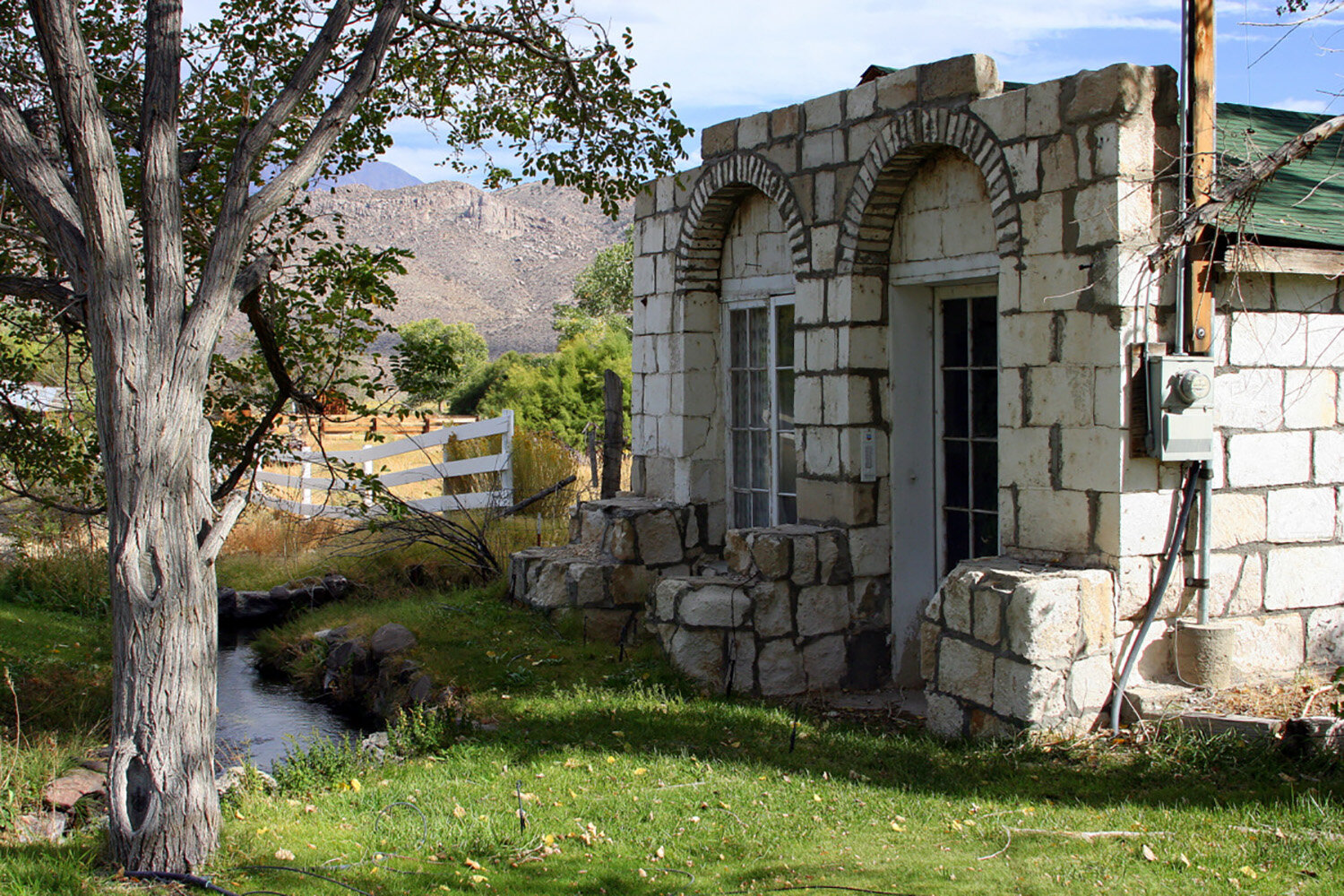
#1: Benton Hot Springs
Benton Hot Springs is a Sprinter van owner’s dream. This privately owned inn and campground is well off the beaten path, nestled in the high desert east of the Sierra Nevada Mountains and just west of the equally impressive White Mountains. The hot springs are about a 45-minute drive from both Bishop, CA and Mammoth Lakes, CA.
What makes Benton unique and highly appealing is that they offer 12 campsites, each with their own private soaking tubs. Every site offers stunning views of the White Mountains. The sites are separated by fences and thick stands of trees. You will have privacy, so clothing is optional, though the owners note that ‘discretion is encouraged’.
Each campsite has a fire pit, a barbecue grill, and a picnic table. The sites vary in size, but the larger sites can fit multiple camper vans and/or cars, and the larger pools can accommodate up to 8 people. There are 5 restrooms to accommodate the 12 campsites. Dogs are allowed at Benton, but they must be kept on-leash. Be sure to bring along some firewood, as there is none available onsite.
Benton offers no RV hookups, but that’s not a problem for people with an off-grid Sprinter van setup. There are few places in the world where you can camp in your van and have around-the-clock access to your own private spring-fed hot tub just feet from your door.
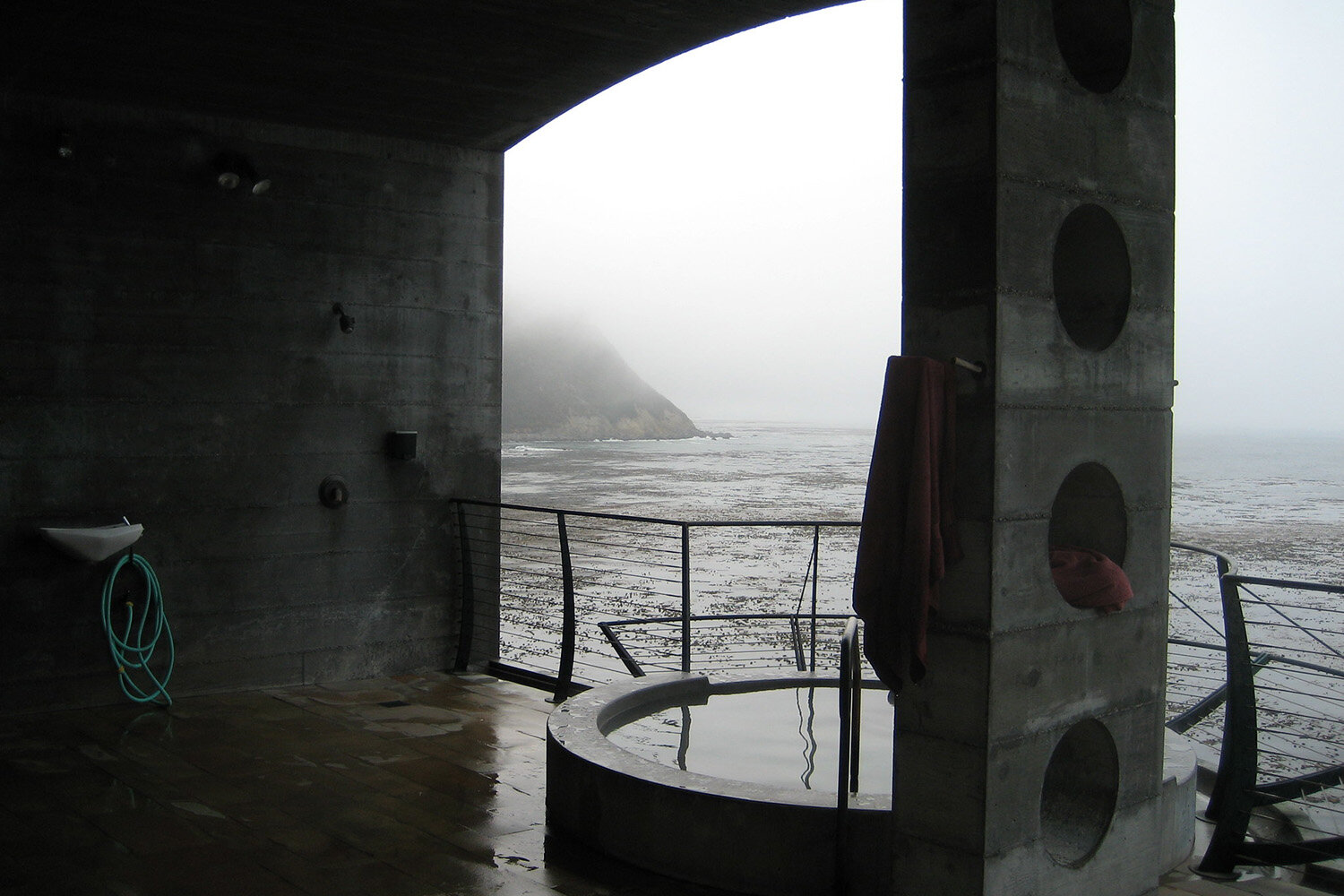
Round Tub – Esalin [sic] Hot Spring by Lewisha1990 is licensed under CC BY 2.0
#2: Esalen Hot Springs
No California road trip is complete without some time spent on the beautiful coastline. Perhaps the most breathtaking stretch of coast in California is Big Sur, where steep cliffs meet pounding waves and secluded beaches hide amongst the rocks.
Esalen Institute is a center for workshops and retreats located on a breathtaking 120-acre piece of land alongside the Pacific Ocean in Big Sur. The land features a natural hot mineral stream that gushes out of a seaside cliff.
Although Esalen is primarily open for those participating in retreats and workshops, they offer night bathing every night from 1:00 a.m. to 3:00 a.m. in their stunning oceanside spring-fed tubs. Reservations are required, and must be made online the same day you wish to bathe (reservations open at 9 a.m. PST daily). The cost is $35 per person. Night bathing at Esalen is a truly unique experience and something you will not soon forget!
Although there is no camping available at Esalen, we recommend booking a site for your Sprinter van at one of the several nearby campgrounds in Big Sur. Or, if you’re up for a splurge, you can book one of Esalen’s many rooms and enjoy less restricted access to the soaking tubs.
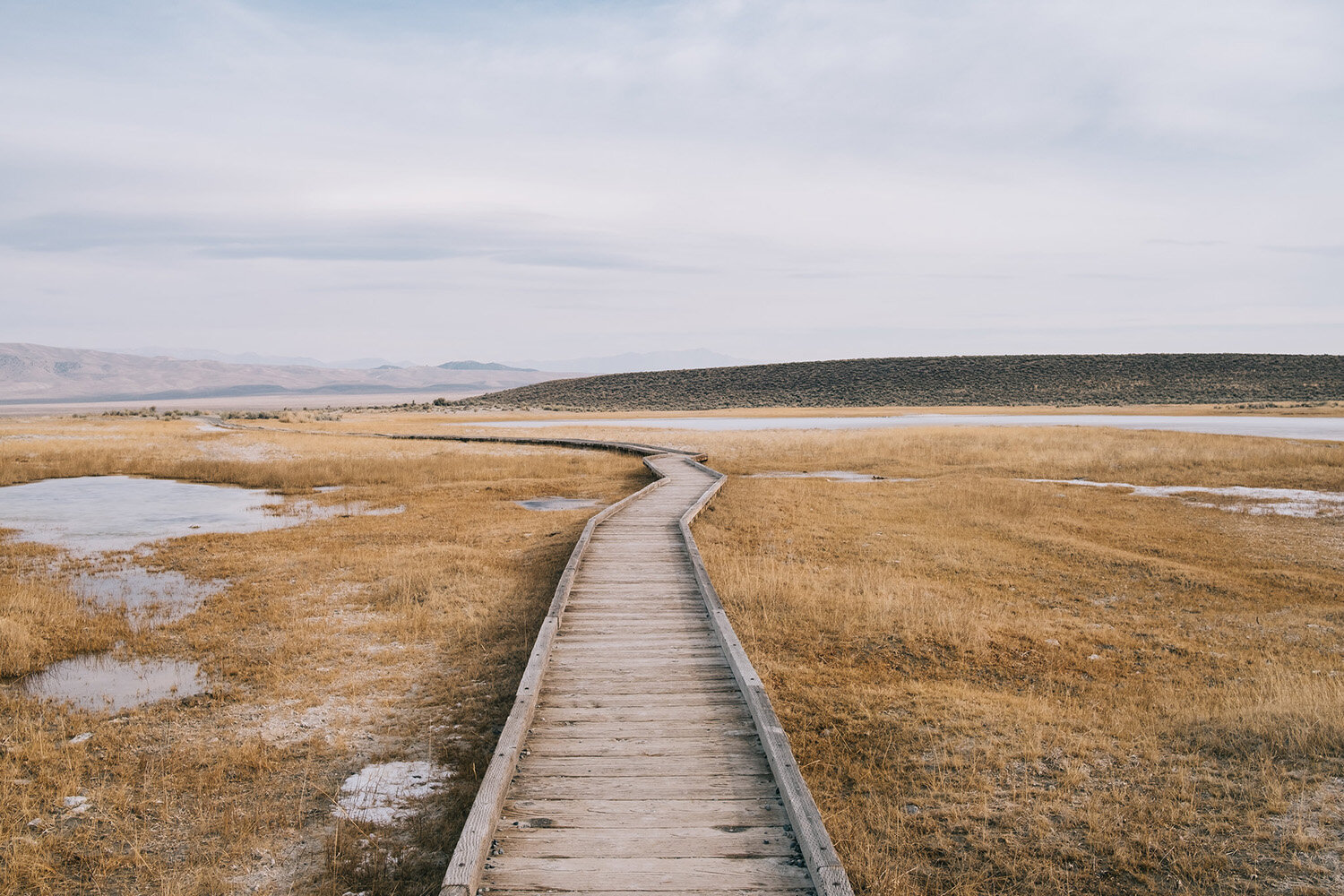
Wild Willy’s Hot Springs by Leng Cheng is licensed under CC BY 2.0
#3: Wild Willy’s Hot Springs
Wild Willy’s is a natural hot spring located just outside of Mammoth Lakes, CA in the beautiful Owen’s River Valley. It is situated on BLM land, meaning you can visit the spring and camp nearby for free. The hot spring features stunning 360-degree views of the surrounding mountain ranges.
This is a “wild” hot spring, so be prepared for a primitive setting with pools that feature a murky, mineral mud bottom. There is a short 3-5 minute walk to reach the springs from the parking area, which is made more enjoyable by an elevated wooden walkway built over a marshy area. You can camp in your van in the parking area, but no amenities are offered and all waste (including human) must be packed out.
To reach Wild Willy’s, turn onto Benton Crossing Road from U.S. 395 just south of Mammoth Lakes, CA. Travel east 2.5 miles, crossing two cattle guards. Just after crossing the second cattle guard, turn right and follow the dirt road. Go left at every fork. After about a mile, you’ll reach the parking area.
If you prefer a developed campground when you are done soaking, check out Brown’s Owen’s River Campground, which is just 5 miles away. It offers heated showers, a general store, and more.
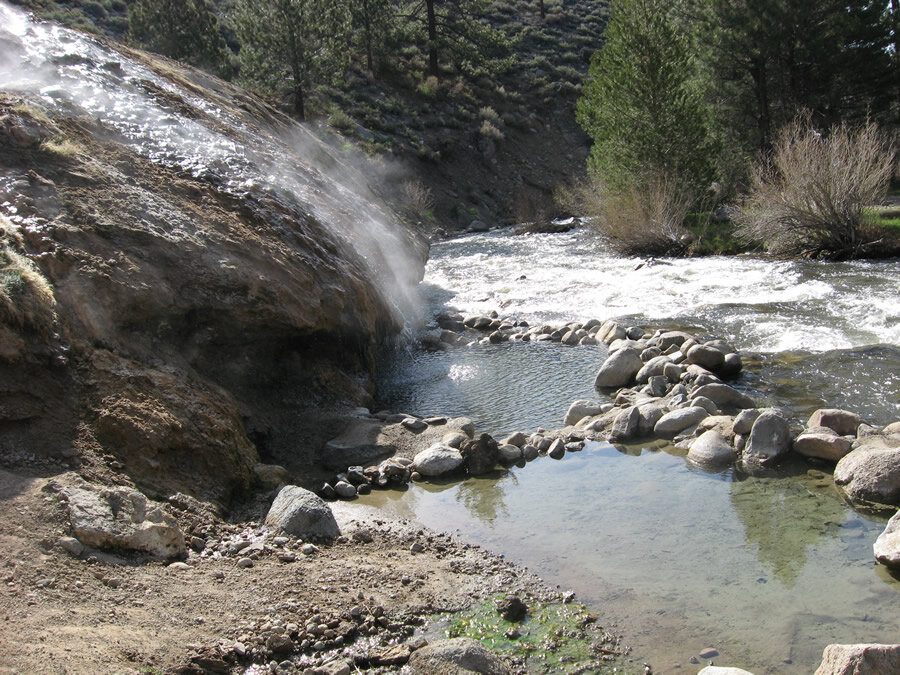
Photo author unknown, from hotwaterslaughter.com
#4: Buckeye Hot Springs
Nestled up against the eastern side of the Sierra Nevada Mountains, Buckeye Hot Springs offers visitors a secluded vibe with expansive mountain views. The soaking pools are located on a hillside above Buckeye Creek, a few miles west of the town of Bridgeport.
What sets Buckeye apart from other hot springs in the area is the fact that you can dip in both hot and cold pools. Buckeye creek comes rushing down from the Sierra’s Sawtooth Range, meaning it stays icy cold all year round. When the hot pools become too much, take a refreshing dip in the creek to cool off.
The closest nearby camping is at Buckeye Campground, which is open mid-April through mid-October, depending on snowpack. The campground is within walking distance of the springs, and Buckeye Creek is also highly accessible.
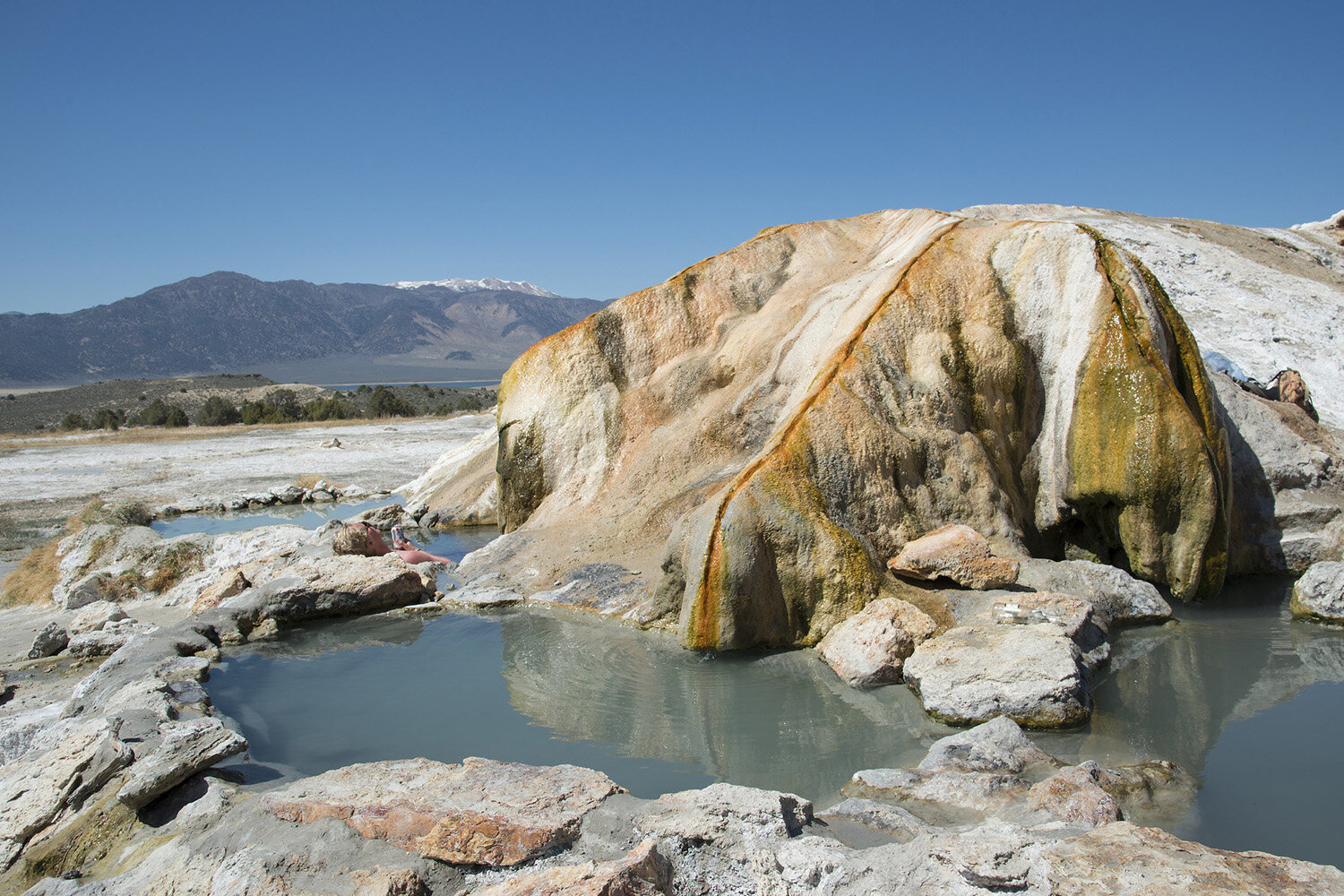
#5: Travertine Hot Springs
On the other side of the town of Bridgeport, to the southeast, you’ll find Travertine Hot Springs. Travertine is one of the most accessible free hot springs in the U.S. One of the pools sits so close to the parking lot that you can just about dip your toes while sitting in your Sprinter camper van!
Travertine features unique mineral deposits and all the pools have a stunning view of the Sierras across the valley. There are at least 4 soaking pools at Travertine within a 5-minute walk from the parking lot. The pools nearest to the parking lot are the hottest, and the uppermost pool closest to the parking is downright piping hot, so be careful as you enter the water.
There is a restroom in the parking area, but no running water. You can camp along the road that leads up to the hot springs for free in various pullouts, but camping in the immediate vicinity of the springs is restricted. To reach Travertine Hot Springs, Take U.S. 395 south from Bridgeport for 1/2 mile. Turn left on Jack Sawyer Road and follow the road to its end, about one mile. You’ll see the restroom and the first pool as you enter the parking area.
If you’re wishing you could hit the road in a thoughtfully designed Sprinter van conversion, and live your best #vanlife, give us a shout. We’re looking forward to connecting with you. Your friends at Muse & Co. Outdoors.
7 Reasons Why #Vanlife in Camper Vans is Better Than Tent Camping
If you’ve experienced both van camping and tent camping, then you’re probably not reading this article. There’s really no question that camping in a Sprinter conversion van is way better than roughing it in a tent.
If you still need a little convincing, we put together this list of reasons why the camper van #vanlife is better than tent camping. Don’t take our word for it, though–just ask any of the thousands of people who have recently begun their Sprinter van journey!
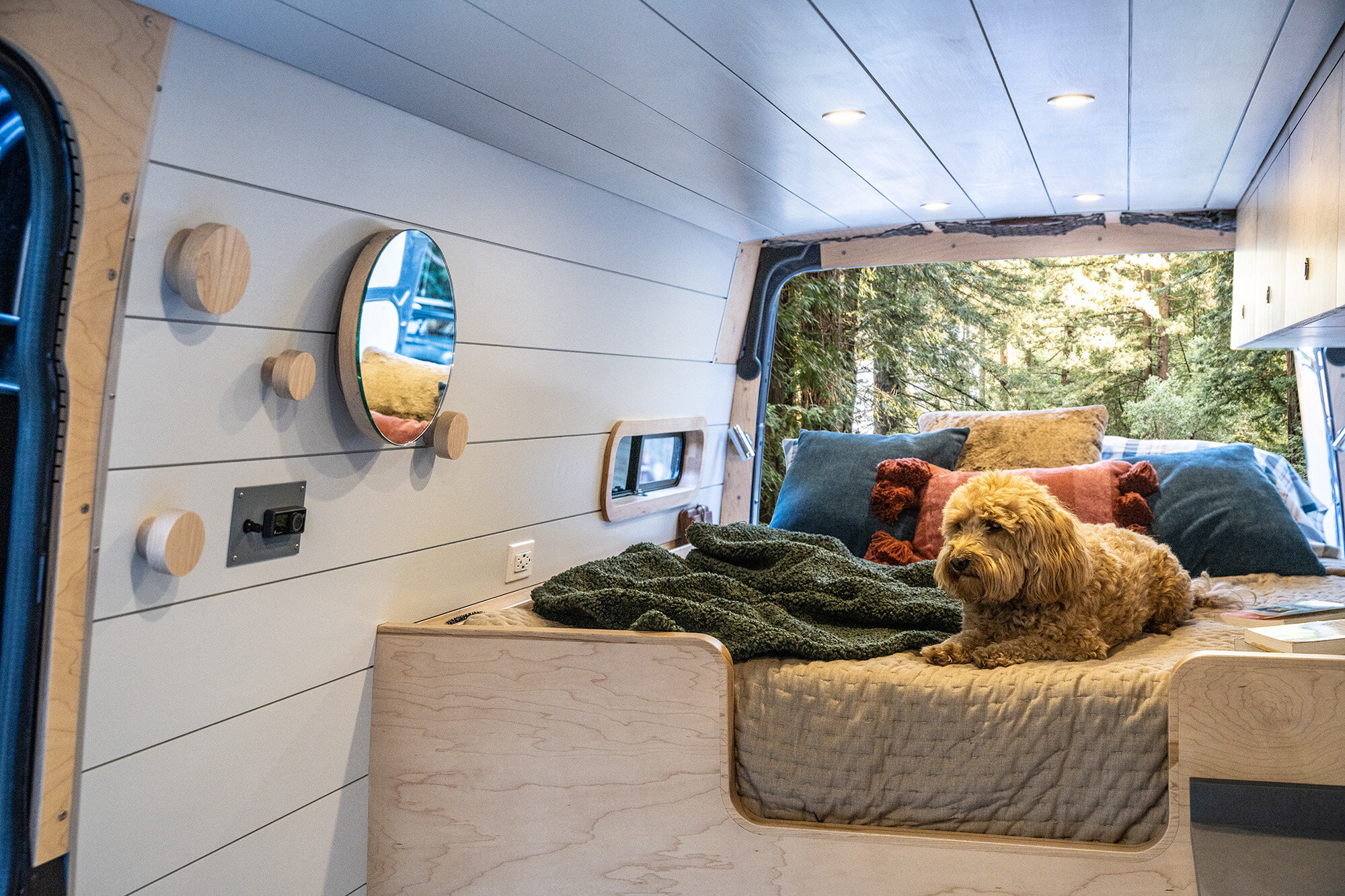
Photo Credit: Muse & Co. Outdoors
1) No Setting Up Camp
Some people might enjoy the ritual of unpacking the tent, finding the flattest spot at the campsite, and setting up a cooking and seating area. But once you get a taste of how easy it is to “set up” a camper van, it’s hard to go back.
All you have to do when you arrive at camp in a van is find a flat place to park, open up the fridge, and crack a cold one! Your shelter is already in place, your bed is made, and your kitchen is ready to prepare dinner. Plus, if it’s raining or cold outside, you don’t have to endure the elements. You’ll stay warm and cozy inside your van.
2) Sleep in a Real Bed
When’s the last time you slept on a queen-sized Casper mattress in a tent? Didn’t think so. One of the great things about camping in a van is that you can have a quality mattress with real bedding.
A blow-up pad and sleeping bag are no comparison to getting a great night’s sleep on a comfortable mattress just like the one in your home. Getting a good night’s sleep while camping helps you to relax and enjoy full days spent exploring outside.
3) Security
One tough thing about tent camping is that there’s nowhere safe to store valuable items. Even your sleeping bag, pad, and tent itself could be stolen if you leave your camp set up while you’re out and about during the day.
Camper vans provide a secure place to store belongings during the day. Plus, if you are camping in an area with bears, your food can stay securely inside of your van as long as you roll up the windows and lock the doors when you leave. You should still follow local guidelines and use a bear locker when available, but bears in most areas will not pursue food inside of a locked vehicle.
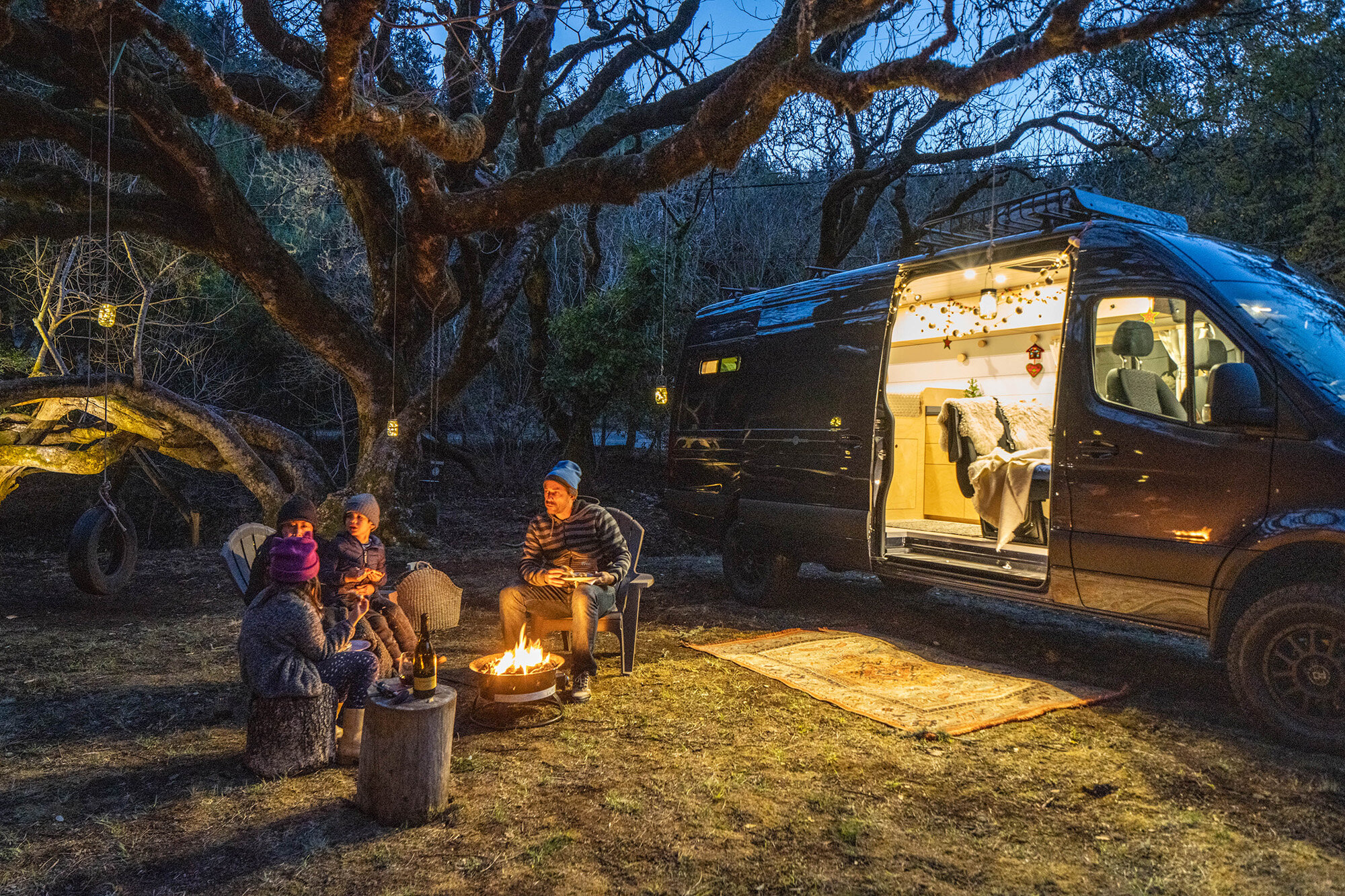
Photo Credit: Muse & Co. Outdoors
4) Your Own Personal Electricity Supply
A Sprinter van conversion isn’t complete without an off-grid 12-volt electrical system. Camper vans use their electrical systems to power appliances like the lights, fan, heater, and fridge, and to charge devices like phones and laptops. While tent camping, you’re lucky if you can even keep your phone charged!
Having a consistent supply of electricity while you’re out camping allows for a much more comfortable and enjoyable experience. You can still always unplug, turn off the lights, and sit by the fire while gazing at the stars. But you’ll love having ample light when you’re cooking, a fan to cool you off on hot days, and the ability to work on your laptop while on the road.
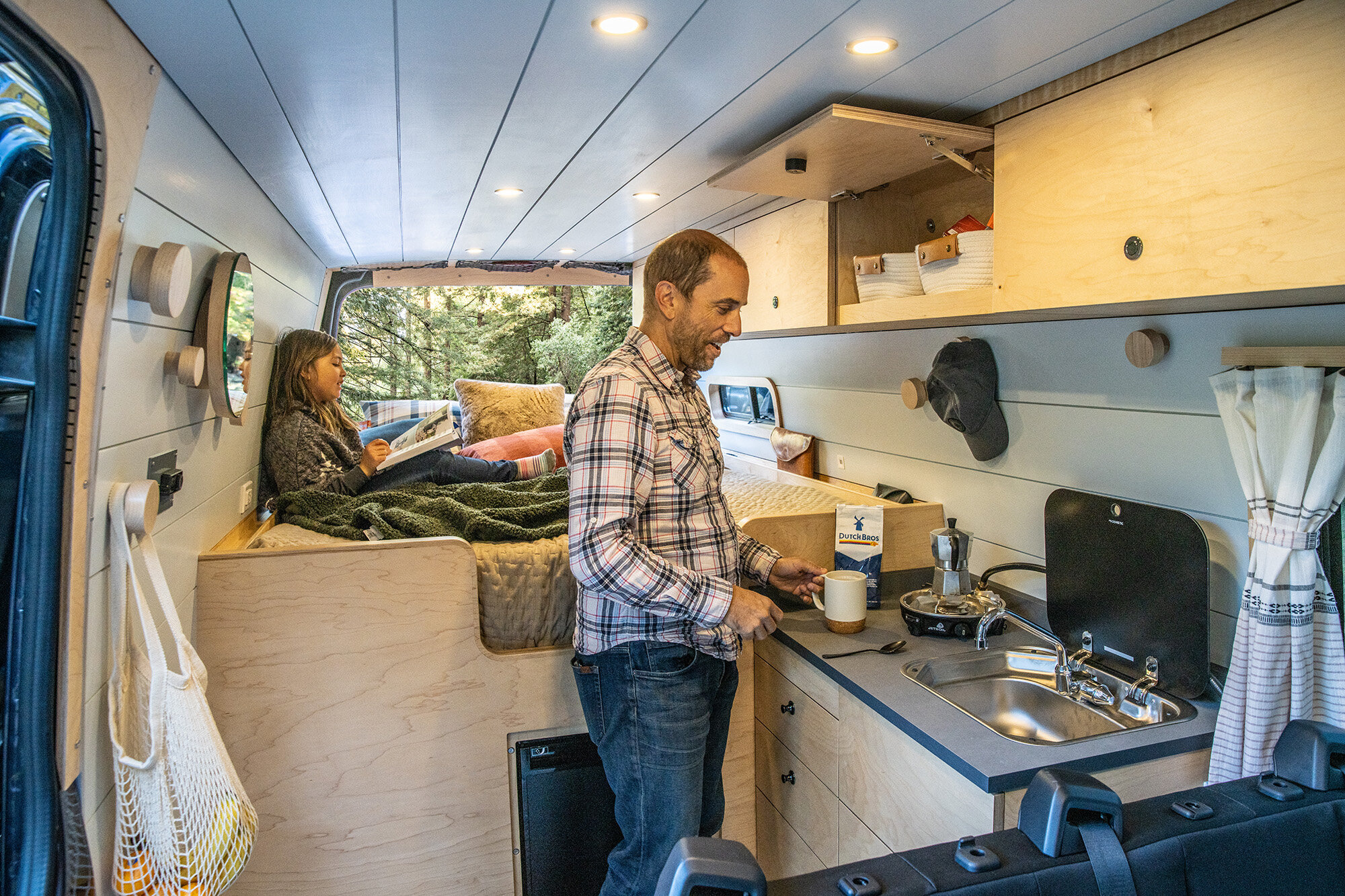
Photo Credit: Muse & Co. Outdoors
5) A Full Kitchen
Let’s be honest…Cooking while camping is a total pain in the butt! But what if you had access to a full kitchen while you were on the road–with a sink, a built-in stove, a fridge, and more counter space than most New York City apartments?! This is what you get when you travel in a custom Sprinter van.
Say goodbye to draining the water-filled cooler, chopping veggies on the flattest rock you can find, and trying to wash dishes in a bucket! With a fully-stocked camper van kitchen, you can make many of the meals that you enjoy at home. With appliances like a fridge, sink, and stove, ample cabinet space for cookware and utensils, and enough counter space to comfortably prepare food, cooking in a camper van kitchen is easy and fun!
6) Climate Control
What if we told you that camping in the mountains during winter could actually be enjoyable? Or that you could enjoy shade and the refreshing, steady breeze of a fan while camping on the coast during a hot summer day? With a Sprinter camper van, you can!
The ability to control the temperature inside of your van is one of the major advantages of this form of camping. Sprinter van conversions can come equipped with a thermostat-controlled heater and a roof vent with fan (All Muse & Co. Outdoors vans come standard with these features). They can also be insulated effectively, so you can keep the warmth in on cold nights and the cool air in on hot days.
Having a true barrier between you and the elements, as well as the option to control the temperature inside of your van, makes camping infinitely more enjoyable when the weather outside is less than perfect.
7) Bring Along all Your Gear
Sprinter vans are big vehicles, and having so much space comes with some serious benefits. If you’ve ever tried to pack bikes, surfboards, and all of your tent camping gear into a small car, you know how difficult it can be to make everything fit.
With a camper van, you’d be hard-pressed to find gear that you can’t bring along for the ride. You can even add a full-length roof rack to your Sprinter van’s roof, expanding the possibilities for carrying larger gear like kayaks and surfboards. Many people live out of their camper vans full-time, so finding the room for a weekend or even weeks-long trip should be no problem!
Are you ready to ditch the tent and start living your #vanlife dreams? Muse & Co. Outdoors is the top choice for Sprinter van conversions in the Bay Area. We offer models to accommodate families, couples, and solo travelers, with virtually infinite options to customize your van and make it your own. Check out our Build My Van tool to get started on your build today!
7 Camper Van Kitchen Essentials to Make Cooking a Breeze
Photo Credit: Muse & Co. Outdoors
Still, no camper van kitchen can quite match the ease of cooking at home. Without luxuries like an unlimited water supply, an oven, and ample cabinet space, you’ll need to tweak your cooking habits a bit to adapt to the van life.
Fortunately, there are some great products out there that can help you take full advantage of your camper van kitchen. Use these Sprinter van kitchen essentials to master the art of preparing food in your van!
1) Steel + Enamel Dishware Set
Plates, bowls, and cups are true essentials for any kitchen. When it comes to choosing dishware for a camper van, there are some special considerations that should be taken into mind.
The main challenge when selecting camper van dishware is that ceramics can break easily due to the bumps and turns of the road. It’s not impossible to have ceramic dishware in a camper van if they are stored very carefully, but it’s much simpler to go with a sturdy material like enamel-coated steel.
We love this dishware set because it’s sturdy, easy to clean, and takes up minimal space in your Sprinter van cabinets. Plus, enamel-coated steel dishware has a great retro look and feel and is a much classier alternative to plastic dishware.
2) Nonstick Cookware
A good nonstick pot and pan set is a camper van kitchen essential. Why? Because using nonstick cookware is going to save you precious dishwashing time (and water).
We’ve all experienced trying to clean a pot or pan that has food crusted to its surface. This is a task that can take as much time, scrubbing, and water as washing all of the rest of a given meal’s dishes, combined!
While extra scrubbing and rinsing might be a minor inconvenience in your home, it can be a real problem in a camper van. Saving water is important when washing dishes in a van, so having cookware that can rinse off quickly after use is critical!
3) Collapsible Tupperware
If your house has a drawer or cabinet that is overflowing with poorly organized food storage containers and lids, you’re definitely not alone. Organizing tupperware is tricky, but you simply can’t afford to take up a lot of space in your van’s kitchen cabinets with food storage containers.
That’s why we love these collapsible silicone food storage containers! This set includes 4 containers of different sizes. When they’re not in use, they collapse down to 1/3 of their original size. The silicone material is completely food safe and it resists sticky foods, so you can clean them quickly after use. Plus, the lids latch securely to the body of the container, so you can bring some leftovers along in your backpack when you head out for the day.
4) Mini Hand Coffee Grinder
Who says traveling in a Sprinter van conversion means you have to drink bad coffee? A key to having a great cup of coffee on the road is using freshly-ground beans. But bringing along your electric grinder from home isn’t practical in a van because of the space it takes up and the electricity it consumes.
That’s why a good-quality portable coffee grinder is a great addition to your camper van kitchen! This Japanese-made grinder is adjustable so you can grind beans for the perfect cup, whether you’re using a drip, french press, or another method. It’s only a few inches tall, so it takes up almost no space in your van’s cabinets. We love the morning ritual of grinding fresh coffee while enjoying the view at our campsite.
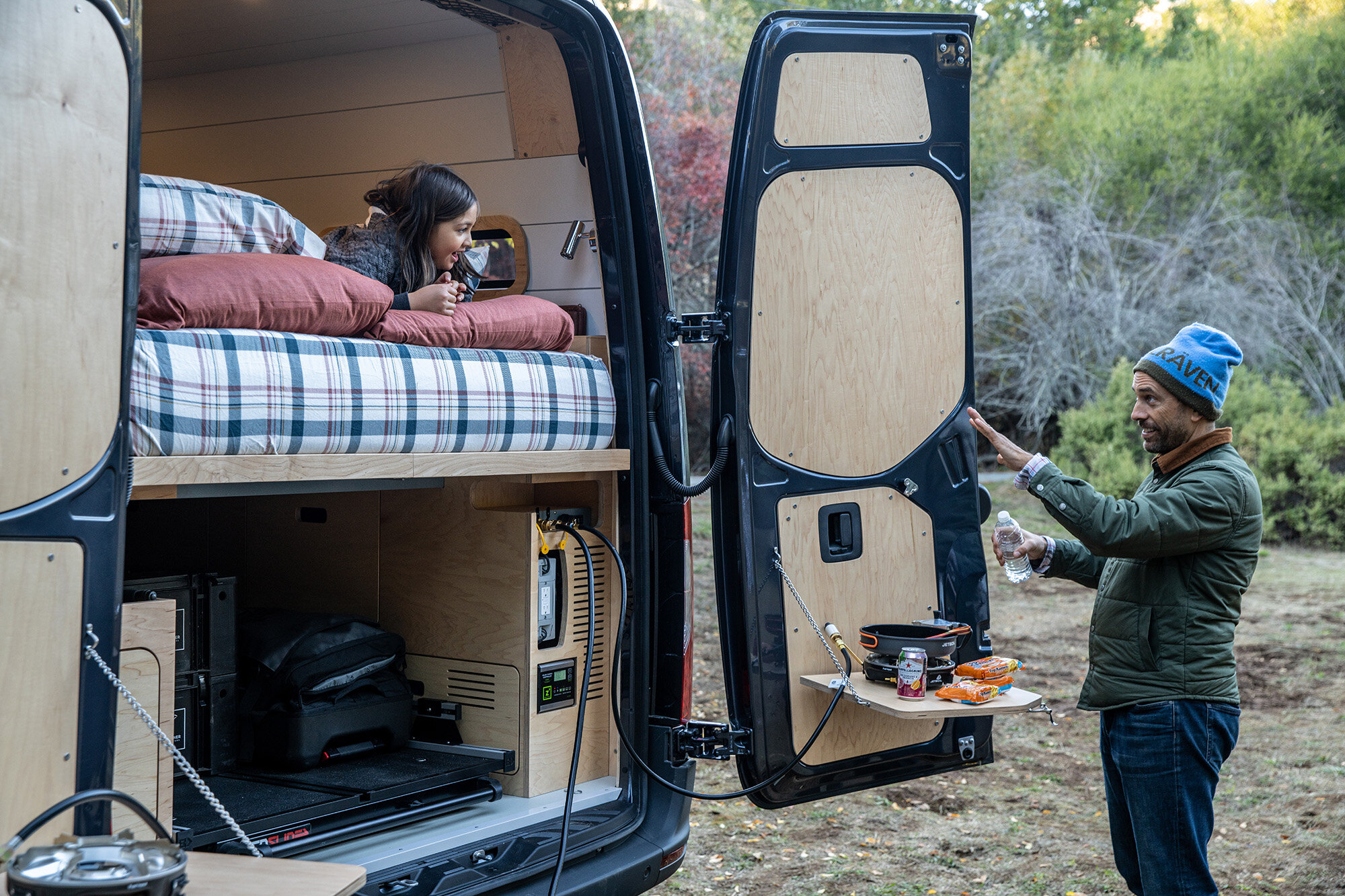
Photo Credit: Muse & Co. Outdoors
5) Pressure Cooker
Pressure cookers a great addition to your camper van’s kitchen. You can use a pressure cooker to make anything from steel cut oats to stews and soups. Because pressure cookers cook foods at higher pressure, cooking times are reduced.
Pressure cookers allow you to make delicious one-pot, home-cooked meals in your van, without taking all day to prepare your food. They are especially useful when you’re camping at high altitude, where things take longer to cook.
Some of our favorite foods to prepare in the pressure cooker include stews and soups, yummy rice dishes, tender meats, and staples like rice and oatmeal (which can be cooked in a fraction of the time using the pressure cooker).
6) Mesh Strainer
A strainer is a great multi-purpose tool for your camper van kitchen. One stainless steel mesh strainer can accomplish the tasks of multiple other kitchen accessories. We use our strainer for all of the following tasks:
- Straining pasta (bye-bye, colander)
- Rinsing rice before cooking
- Catching seeds when juicing lemons
- Rinsing fruits and vegetables in the sink
- Steaming vegetables
- Washing and drying salad greens
These are just some examples of kitchen tasks that can be accomplished with a strainer. We use ours just about every day in our van and it removes the need to carry many other tools.
7) Insulated Mug
Insulated mugs, or ‘travel mugs’ are a camper van must-have. They are capable of keeping beverages hot for long periods of time. Whether you want to bring some hot cocoa out by the fire, or keep your coffee warm for longer in the morning, the way to do it is with an insulated mug.
Another reason travel mugs are great for camper vans is their spill-proof lids. This feature is a must-have for those days when you get up, make coffee, and start driving. And, if you accidentally leave your mug on the kitchen counter and start driving (we’ve all been there), you can avoid a major spill.
These camper van kitchen essentials can help you master the art of preparing food and drink on the road! Of course, your van will need a great kitchen to begin with—one with ample cabinet space, and great features like a built-in sink and fridge. Muse & Co. Outdoors vans include all these features, and a lot more. Head over to our details page to learn more about our builds!
A Complete Guide to Camper Van Bathrooms
Photo credit: Karolina Grabowska from Pexels
With so many inexperienced camper van travelers thinking about trying out the van life, some common questions are being repeated. Among them is something we hear people ask time and time again: “where is the bathroom?!”. The truth is, there are multiple solutions to address the need for a bathroom in a space as small as a camper van.
The two main aspects of a bathroom are the toilet and the shower. In a house, a full bathroom takes up a minimum of about 35 square feet. In a van, 5 square feet would be seriously pushing it! So, what are the various ways to fit a bathroom into a camper van, and which solution is the best? Keep reading to find out!
Camper Van Toilet Options
When it comes to using the loo in a camper van, there are a few common options. Each option has pros and cons when it comes to convenience and space consumption. It’s important to keep in mind that just about any camper van toilet option is going to feel less comfortable than using the bathroom in your house. For this reason, most van owners only use their toilets when there are no public restrooms available, or when they don’t want to go outside the van.
Option #1: The Glorified Bucket
That’s right – one of the most common toilet options in a camper van is essentially a 5-gallon bucket with a lid that resembles a toilet seat. Bags are inserted into the bucket for easy cleanup when going number two, and to improve sanitation. Most van owners that carry these only use them for absolute emergencies and opt for either using public restrooms, or going outside when applicable.
The benefits of this kind of camper van toilet include having an option for emergencies without taking up very much space inside of your van. Additionally, this is a super affordable item at under twenty dollars. However, for those planning to use their camper van toilet on a more regular basis, the ‘bucket toilet’ is not going to cut it.
Option #2: The Cassette Toilet
A cassette toilet, also called a cartridge toilet, is similar to an RV toilet but is more suited for use in a camper van. The main difference that sets a cassette toilet apart from a traditional RV toilet is that it includes a removable and portable holding tank. The tank can be removed and dumped at dump stations or in public restrooms.
If you’re using a cassette toilet to go number two, you can add chemicals to the tank to control the smell and break down the waste. Otherwise, the toilet can be emptied and rinsed every time you use it to avoid any odors.
Option #3: The Composting Toilet
Composting toilets are quickly becoming the most popular option for camper vans. As the name suggests, these toilets use composting fibers such as coconut husks to break down waste.
Some composting toilets feature a side for pee and a side for poop, with separate holding tanks. The pee side can be dumped regularly and rinsed out. If you use the toilet for number two, you add some of your fibers to the tank and the natural composting process takes care of the waste. You can dump the contents of the holding tank into a trash bag, which can be disposed of in a garbage can. This must be done every three weeks or so. Because of the composting process, odors are kept to a minimum.
Camper Van Shower Options
A shower is the second key bathroom element that can be included in a camper van. While many vans do not have showers at all, having the ability to rinse off at the end of a long day spent climbing, biking, or surfing is quite a luxury.
There are two main challenges when it comes to adding a shower to a camper van: finding the space and heating the water. There are various ways that van builders work around these challenges when adding a shower to a Sprinter van conversion.
Option #1: The Built-In Shower
Some van owners opt to go with a permanent, built-in shower in their camper van. This option takes up the most space and will require a large fresh and grey water tank, water heater, and ample power to heat your water.
Having a permanent and enclosed shower in your van makes for the most versatile and convenient showering experience, but there are many downsides to going this route. Major modifications must be made to several areas of your build to accommodate for a built-in shower.
Not only will the shower take up a massive amount of space in the van, but it will also require huge fresh and greywater tanks, complex plumbing, and expensive upgrades to your electrical and/or propane system to handle the load of the water heater. While these costs may be worth it for someone living in their van full-time, it’s hard to justify an indoor shower for most van owners.
Option #2: The Portable Solar Bag Shower
On the other end of the spectrum, there are some shower options that are very cheap, take up hardly any interior space, and draw zero power from your van’s electrical system. Solar bag showers like the Sun Shower are a popular budget option for some van owners.
These showers are as simple as they sound – a 4-gallon bag that you fill with water, leave out in the sun to heat up, and then hang somewhere high on a tree or on your van to create enough pressure to rinse off with. These are a good option for those who only need a shower for emergencies and rare occasions. Although they are cost-effective and space-saving, they aren’t convenient enough to make them viable for regular use.
Option #3: The Road Shower
The Road Shower is a solar-heated, pressurized shower that is specifically designed for use on camper vans and other off-grid vehicles. The Road Shower is a great option for Sprinter van owners – providing ample hot, pressurized water without drawing from the van’s water and electrical supply or taking up any interior space.
The Road Shower comes in 4, 7, and 10-gallon sizes, and you can add more than one to your van’s roof rack if you wish. The shower can be pressurized using a hand or electric pump, but it also self-pressurizes when you fill it with a garden hose. It captures the heat of the sun to provide hot water wherever our closest star shines.
The Road Shower is highly versatile – it can be used for washing dishes or rinsing off dirty pets. It is independent from your van’s main water supply, so it can also be used as extra water storage when you go deep down the backroads. The only downside of the Road Shower is that it does not supply hot water when the weather is cold and cloudy – but this is a small pitfall given the shower’s versatility and ease of use.
So, What Kind of Bathroom Do Muse & Co. Outdoors Vans Have?
Muse & Co. Outdoors vans do not come standard with a toilet or a shower, but we have options to add both to our builds. When customers do want a bathroom, we can add either a composting or cassette toilet into an integrated slide-out drawer. We can also install Road Showers on any Sprinter van with a roof rack.
Our Shower Package includes a 10 gallon Road Shower, a hose with a spray nozzle, and an optional custom curtain setup for your Sprinter van’s rear barn doors. You can enjoy your warm outdoor shower with complete privacy using this setup! Our Toilet Package includes your choice of either a composting or a cassette toilet, an integrated slide-out storage space, and composting material if you go with that option.
If you are in need of a fully enclosed bathroom in your van, we can work with you on a custom build! Get in touch with us today to start building the van of your dreams!
